Posts Tagged by matt anderson
Saluting the Students of the AAA School Safety Patrol®
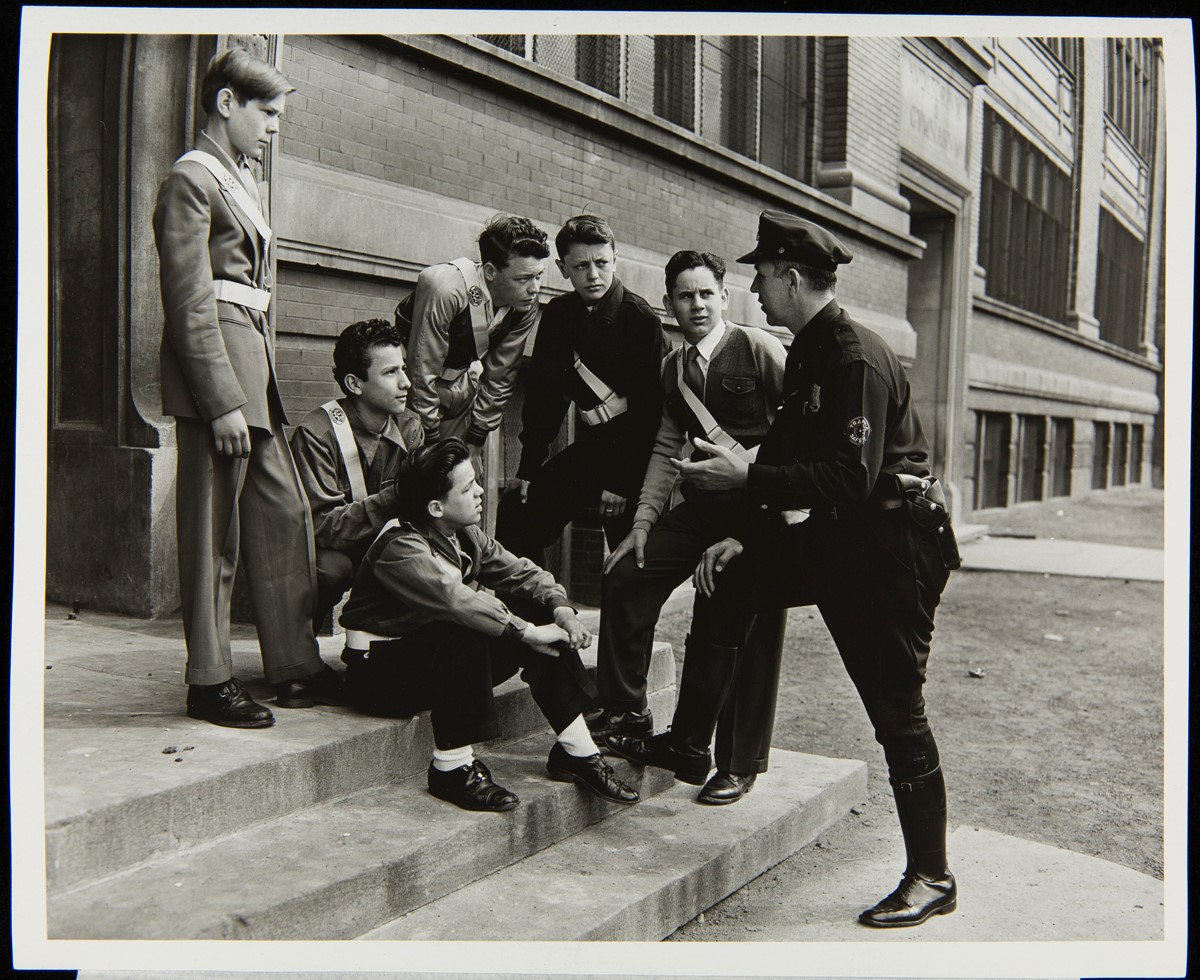
Members of Detroit’s Houghton School safety patrol listen attentively to traffic safety officer Anthony Hosang in 1950. (64.167.536.16)
Like clockwork, fall’s arrival brings with it a return to school for children throughout the United States. Whether they walk, ride a bike, take a bus, or get dropped off by an adult, the students’ daily trips to and from class will be safer thanks to the dedicated efforts of the AAA School Safety Patrol. Established by the American Automobile Association in 1920, the program’s core mission – to encourage safety awareness among young people – remains unchanged.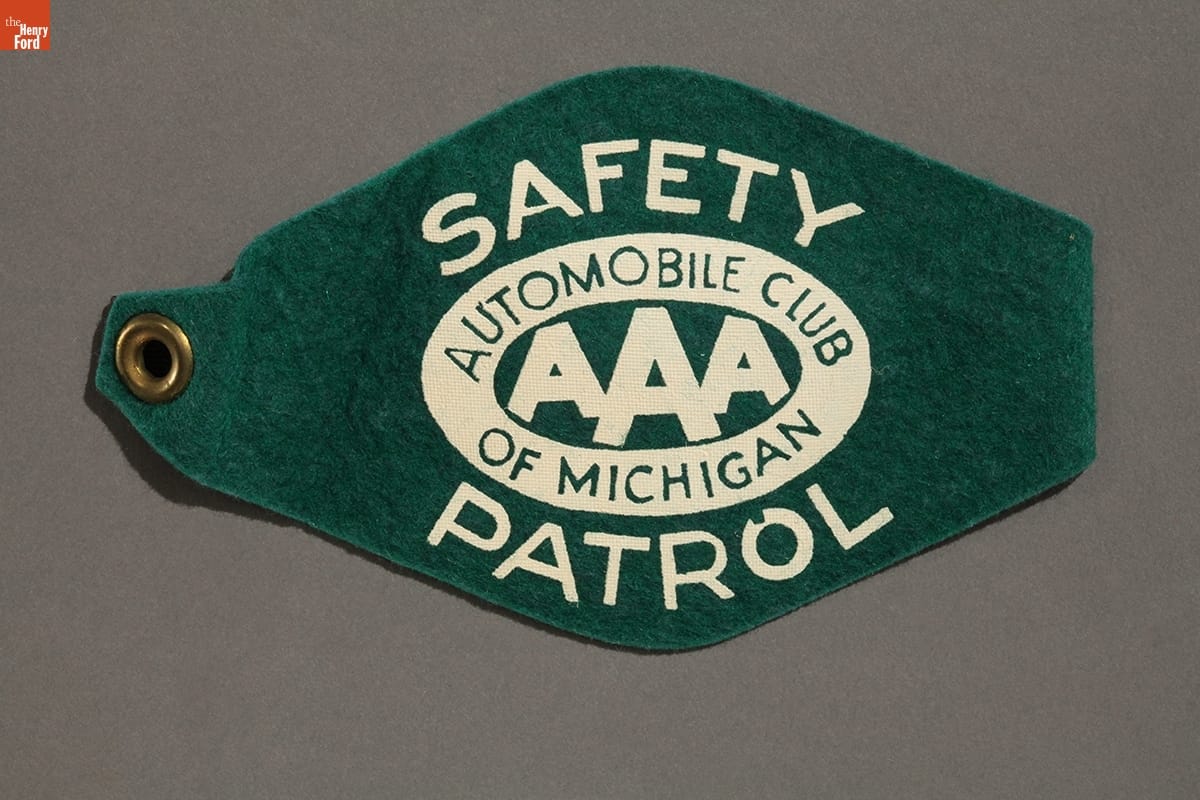
Automobile Club of Michigan Safety Patrol Armband, 1950-1960. THF153486
AAA School Safety Patrol members generally are chosen by their teachers or principals and, with their parents’ permission, given training in traffic safety – typically over the summer, so they’re ready to go as soon as the school year starts. These young patrollers are then stationed near the school at crosswalks, bus unloading areas and carpool drop-off locations to ensure that their fellow students remain cautious near motorized traffic.
More experienced patrollers may be promoted to officer positions like captain, lieutenant or sergeant. These ranks bring with them additional responsibilities like keeping daily records, writing regular reports, or assigning other patrol members to specific duties or stations.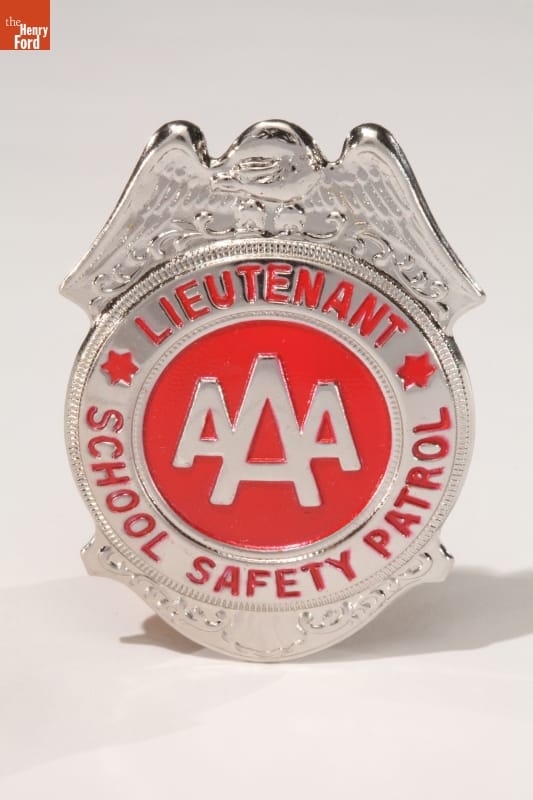
AAA School Safety Patrol Lieutenant Badge, 1950-1965. THF151056
It’s important to note that safety patrol members work together with – not in place of – adult crossing guards and traffic officers. Nevertheless, the patrollers play an important role in keeping students safe. And they learn early and important lessons about responsibility, too. Not surprisingly, many safety patrol alumni go on to careers characterized by public service or proven leadership. Former patrollers include Presidents Jimmy Carter and Bill Clinton, and notable Michiganders like Governor William Milliken, Chrysler Chairman Lee Iacocca, and Detroit Tiger Al Kaline.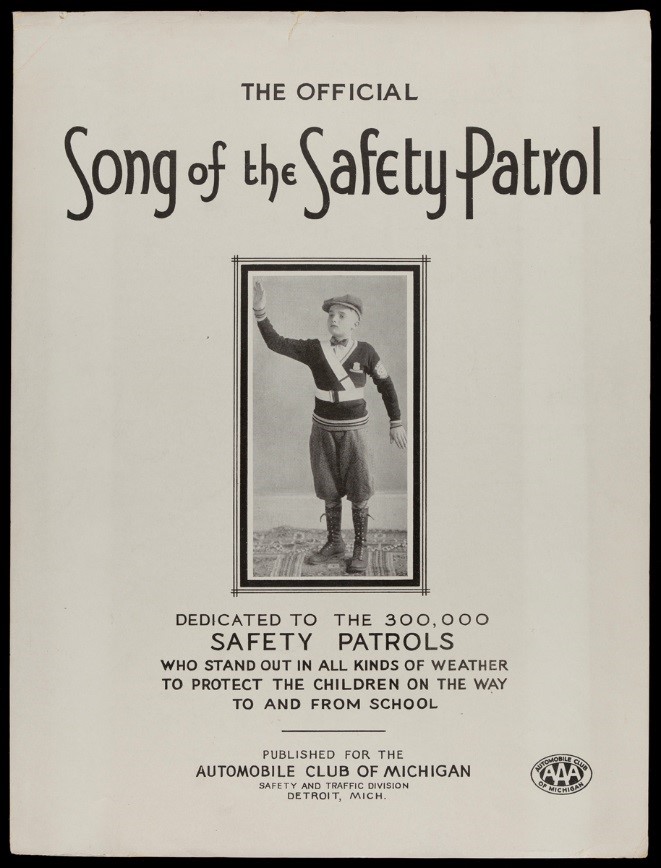
The Official Song of the Safety Patrol, 1937. (87.135.1661)
The Henry Ford’s artifact collection includes armbands and badges worn by AAA School Safety Patrol members over the years. Our archival collection includes a copy of the sheet music for “Song of the Safety Patrol,” written by Lucille Oldham in 1937.
We salute these conscientious students working tirelessly throughout the school year to keep their classmates safe. Today, there are more than 654,000 children serving as patrollers in schools across the United States. Thanks to the program these students are empowered with a sense of responsibility and leadership as they protect their classmates going to and from school each day.
21st century, 20th century, school, childhood, by Matt Anderson, AAA
Trucks Take the Spotlight at the 2018 Old Car Festival

Factory-built trucks, like this 1931 Ford Model A pickup, were the highlight at this year’s Old Car Festival in Greenfield Village.
Another summer car show season has come and gone, but it was capped off in spectacular fashion with the 68th annual Old Car Festival. More than 750 bicycles, automobiles and trucks filled Greenfield Village with the sights and sounds of motoring circa 1900-1932.
This year’s theme commemorated a century of factory-built trucks. Chevrolet introduced its first half-ton and one-ton trucks in 1918. Ford technically built its first Model TT trucks in 1917, but TT production that first year was so small that it seems fair to celebrate the Ford truck centennial in 2018, too. Regular Old Car Festival attendees know that – despite the show’s name – trucks have long been a part of the event, but this year the spotlight was theirs. In addition to the many participant trucks, our friends at the GM Heritage Center kindly provided a 1926 Chevrolet Superior Series X pickup for display, while we pulled out a 1925 Ford Model TT stake truck from The Henry Ford’s collection.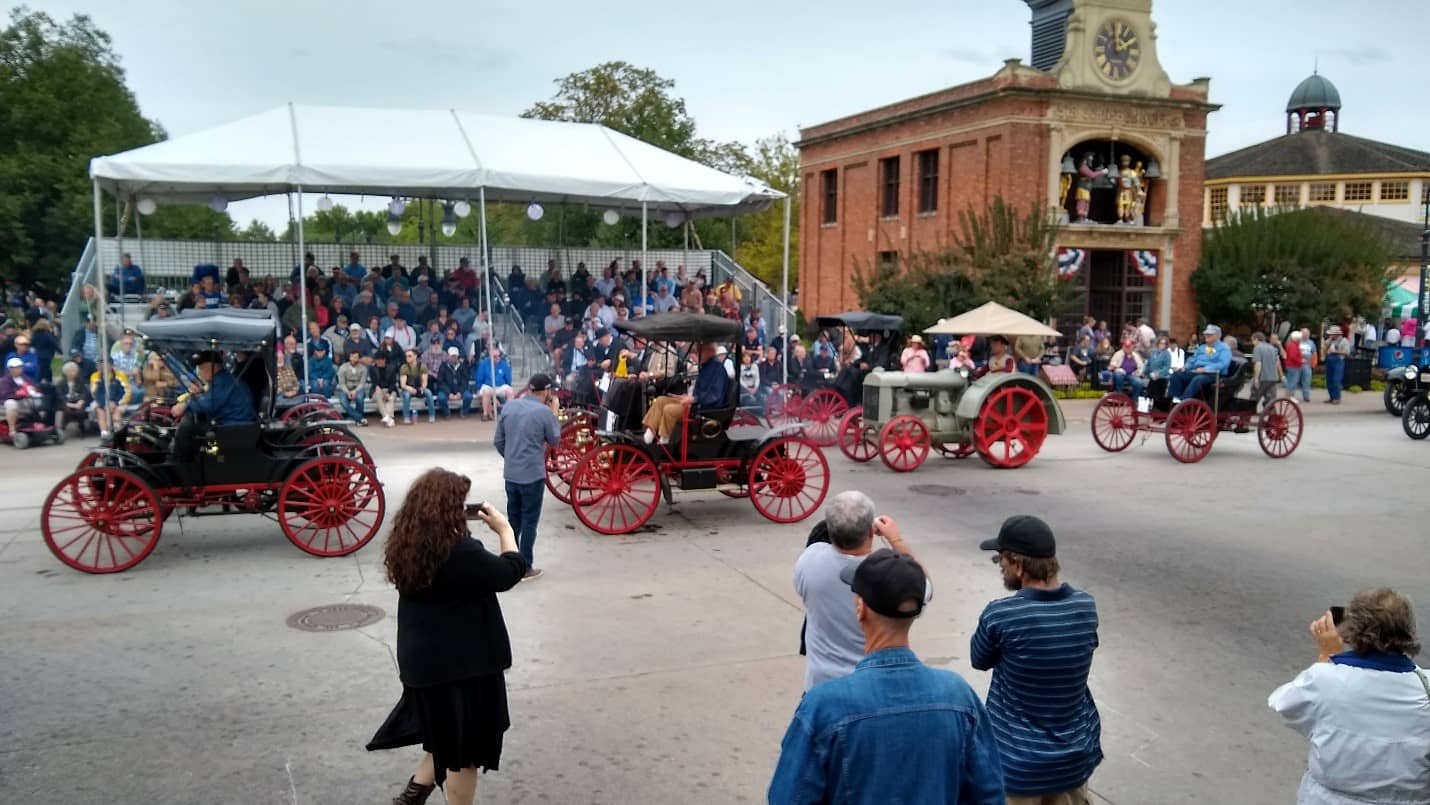 A group of eight Sears high wheelers heads through Pass-in-Review – with the non-runner towed by a 1921 Fordson Model F tractor.
A group of eight Sears high wheelers heads through Pass-in-Review – with the non-runner towed by a 1921 Fordson Model F tractor.
Old Car Festival always brings together a mix of the rare and the common, the strange and the standard, and this year was no exception. Among the highlights was a group of eight Sears high wheelers. From 1909 to 1912, aspiring motorists could order complete cars (along with just about everything else) from the Sears catalog. Priced around $400, the cars were solid if not spectacular, but their arrival was something of a cultural milestone. If *Sears* was selling them, then surely these horseless carriages were here to stay!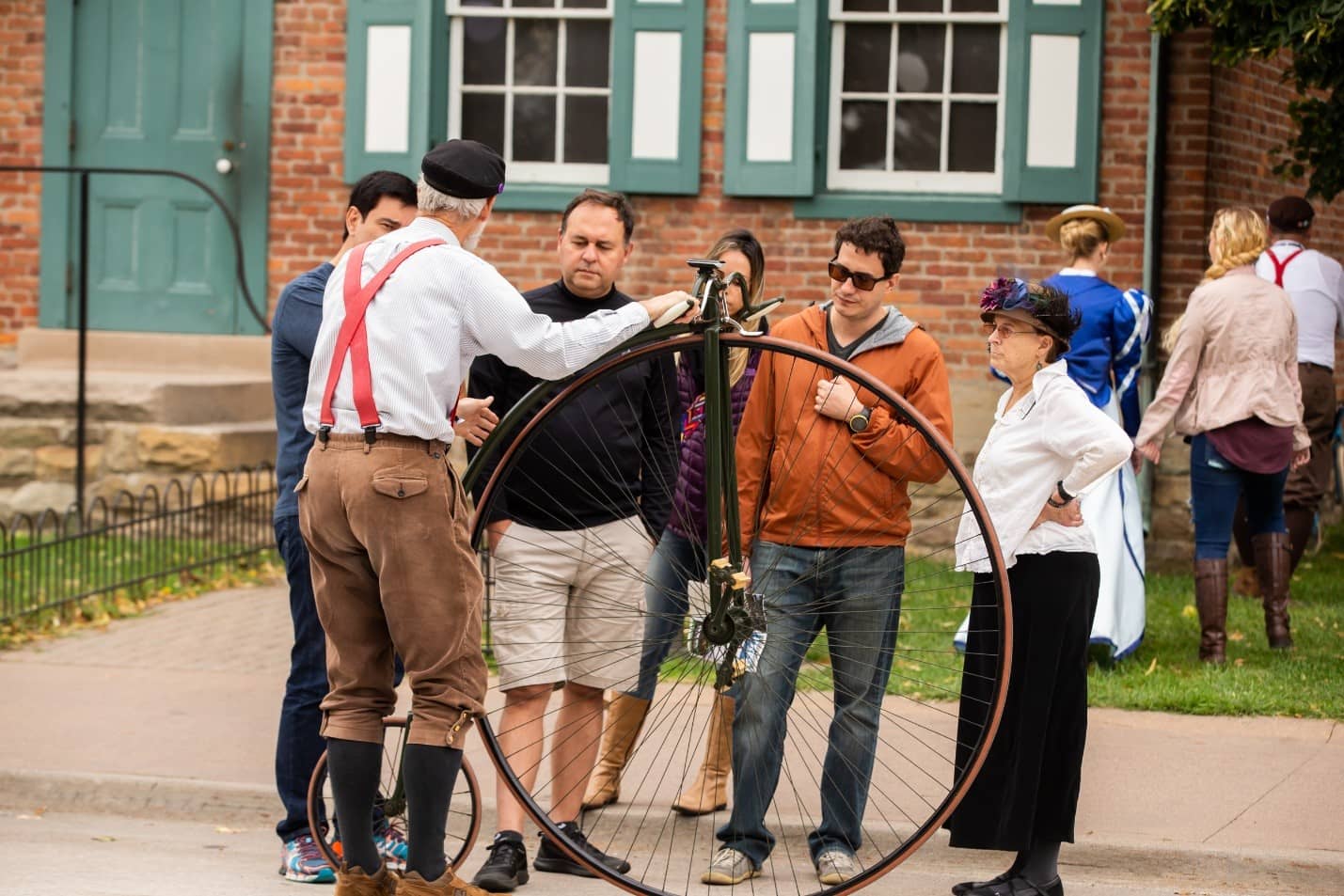 Even 130 years after “safety” bicycles supplanted them, high-wheel “ordinary” bikes continue to fascinate.
Even 130 years after “safety” bicycles supplanted them, high-wheel “ordinary” bikes continue to fascinate.
Not every vehicle at Old Car Festival had a motor. Once again members of the Michigan Wheelmen brought a variety of period bicycles, from a replica of a circa 1817 draisine (the bicycle’s earliest, peddle-less ancestor), to intimidating high wheelers of the 1870s, to more conventional “safety” bikes of the sort Wilbur and Orville Wright sold in the 1890s. Throughout the weekend, the Wheelmen wowed the crowds with their displays of skill – from bicycle games, to stunts, to simply managing to climb aboard something with a front wheel 58 inches high. Visitors enjoyed an additional musical treat this year as organist Dave Wagner performed hit songs of the early automobile era on the newly-restored pipe organ in the Menlo Park Laboratory.
Visitors enjoyed an additional musical treat this year as organist Dave Wagner performed hit songs of the early automobile era on the newly-restored pipe organ in the Menlo Park Laboratory.
Our decade vignettes, so popular last year, returned for 2018. For the Aughts, we had a group of Civil War veterans enjoying a G.A.R. reunion picnic (with a period-appropriate blend of horse-drawn and motorized transportation). For the 1910s, we had a Ragtime street fair complete with fast-fingered pianists, vintage games, and tasty foods along Washington Boulevard. At the other end of the village near Cotswold Cottage – “over there,” if you will – a group of World War I reenactors commemorated the centennial of the Armistice. The Roaring ’20s were recalled with a concert and dancing at the bandstand near the Ackley Covered Bridge. And the somber early years of the Great Depression came to life through the blues guitar of the Rev. Robert Jones.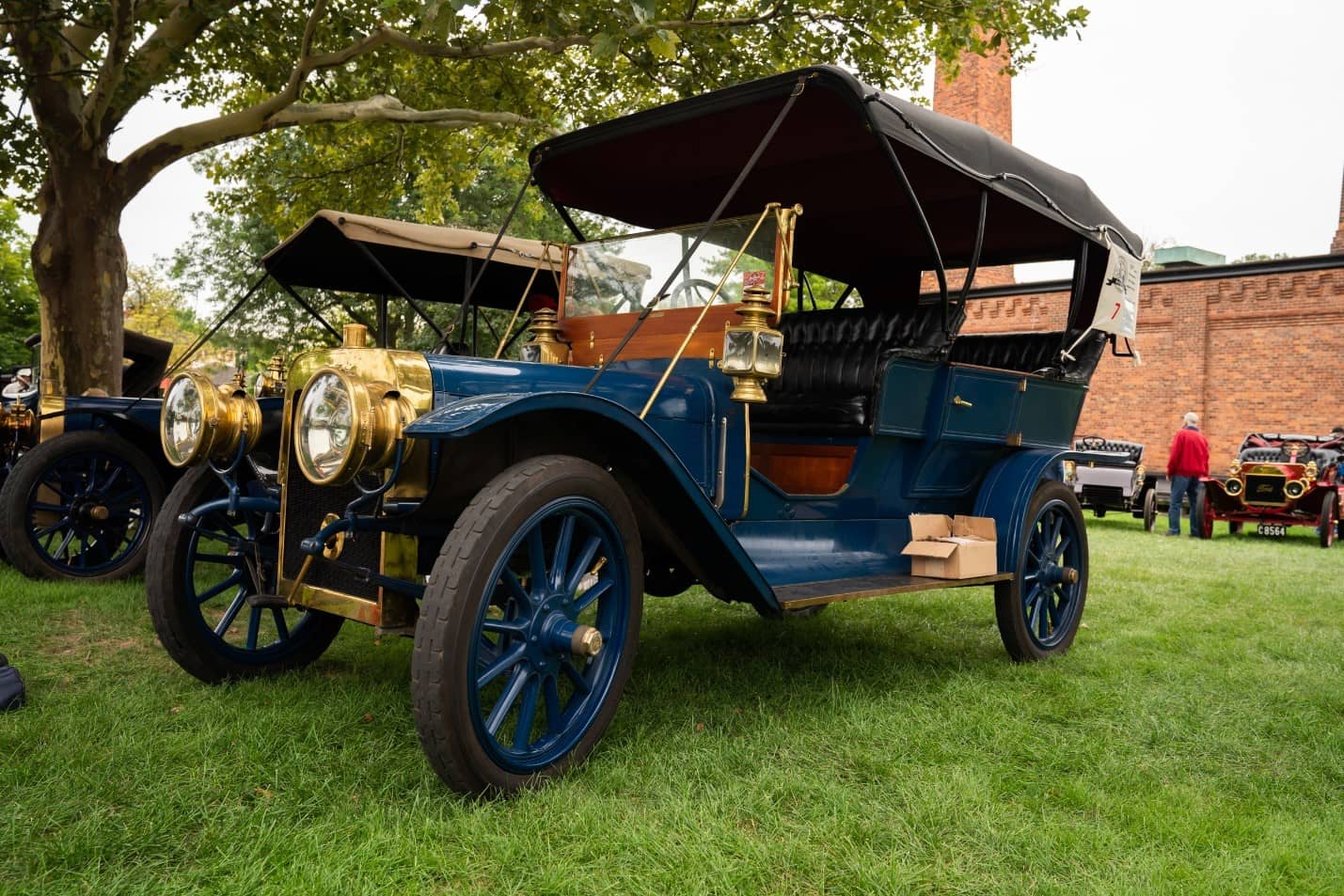 Another rare sight: five Model K Fords attended the show. Today the big six-cylinder K is unfairly dismissed as a failure. In truth, it sold well – and quite profitably – between 1906 and 1908.
Another rare sight: five Model K Fords attended the show. Today the big six-cylinder K is unfairly dismissed as a failure. In truth, it sold well – and quite profitably – between 1906 and 1908.
Whether it was your first visit or your 21st, Old Car Festival surely offered something to bring a smile to your face or a tap to your toe. It’s a car show like no other, and one we’ve been proud to present year after year.
Matt Anderson is Curator of Transportation at The Henry Ford.
Michigan, Dearborn, 21st century, 2010s, Old Car Festival, Greenfield Village, events, cars, car shows, by Matt Anderson
Driving Through the Decades at Motor Muster 2018
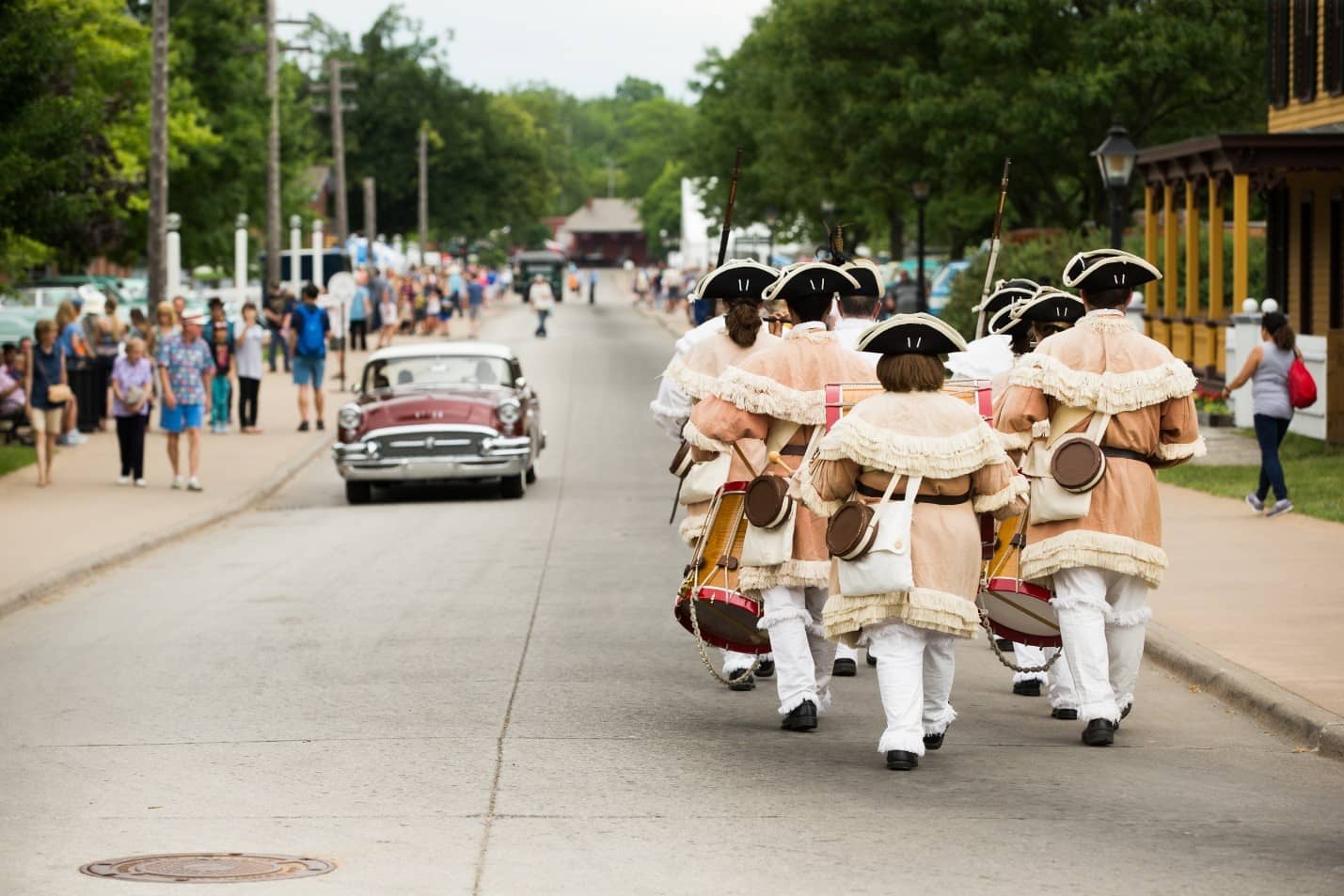
Only at Motor Muster! The 1st Michigan Fife & Drum Corps passes a 1955 Buick Special Riviera.
Another summer means another car show season. Here at The Henry Ford, that means another Motor Muster. Our 2018 event goes down as one of the most exciting in recent memory, with a host of new activities and experiences – and more than a few great cars, too. Some 700 automobiles, trucks, motorcycles, scooters, bikes and military vehicles filled Greenfield Village with the sights and sounds of mid-20th century motoring.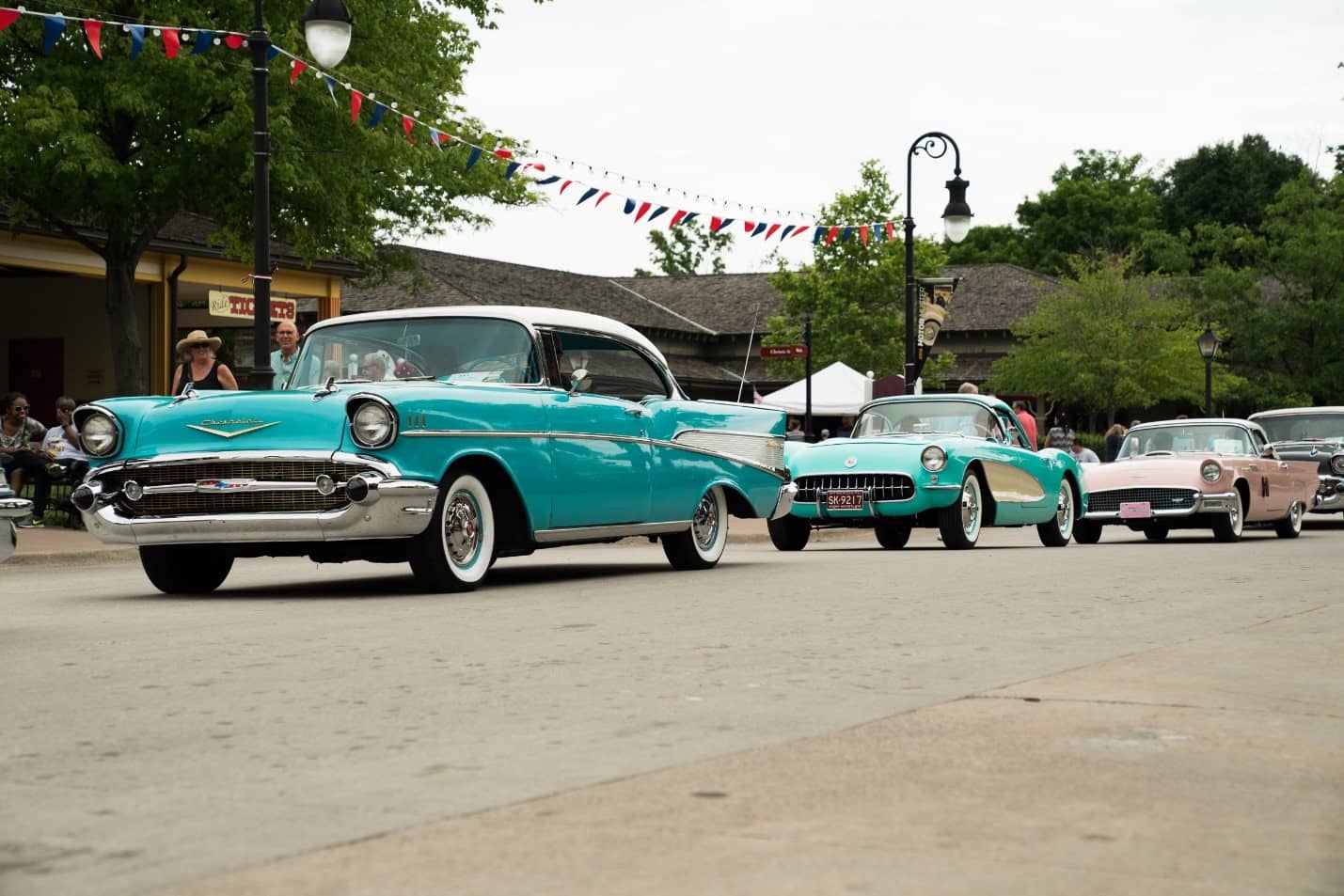 Chevrolet’s long-running small-block V-8 – under the hoods of the 1957 Bel Air and Corvette seen here – is a perfect example of an iconic engine.
Chevrolet’s long-running small-block V-8 – under the hoods of the 1957 Bel Air and Corvette seen here – is a perfect example of an iconic engine.
Our theme this year broke with tradition. Rather than feature one particular make or model, we celebrated “Iconic Engines of Detroit’s Big Three.” Our profiled power plants included Ford’s flathead V-8, which brought horsepower to the masses from 1932-1953; Chevrolet’s small-block V-8, which remained in production, in one form or another, from 1955-2003; and Chrysler’s celebrated hemispherical combustion head engines, first marketed under the “FirePower” name before gaining the better known – and still used – “Hemi” moniker. The broader theme allowed us to make the most of a visit from the Early Ford V-8 Club of America, as well as a consortium of dedicated Mopar owners and fans. Moving under its own power for the first time in several years, The Henry Ford’s 1956 Chrysler 300-B recalled NASCAR’s early days.
Moving under its own power for the first time in several years, The Henry Ford’s 1956 Chrysler 300-B recalled NASCAR’s early days.
Each of these iconic engines was on view in our special display tent across from Town Hall. From The Henry Ford’s own collection came a 60-horsepower variant of the Ford V-8. Our Chrysler 300-B, from the Carl Kiekhaefer team that dominated NASCAR’s 1956 Grand National series, not only sat in the tent but also wowed crowds with Hemi-powered noise during our Saturday afternoon racing Pass-in-Review presentation. We rounded out the tent’s Big Three display with a small-block-powered 1955 Chevy Bel Air courtesy of show participant John Dargel.
The Ford V-8 was an especially appropriate choice for Motor Muster. Some of the engine’s early design work was done by a small group of engineers working out of Thomas Edison’s Fort Myers Laboratory in Greenfield Village. The lab provided the team with privacy and freedom from distraction – and maybe even a little inspiration.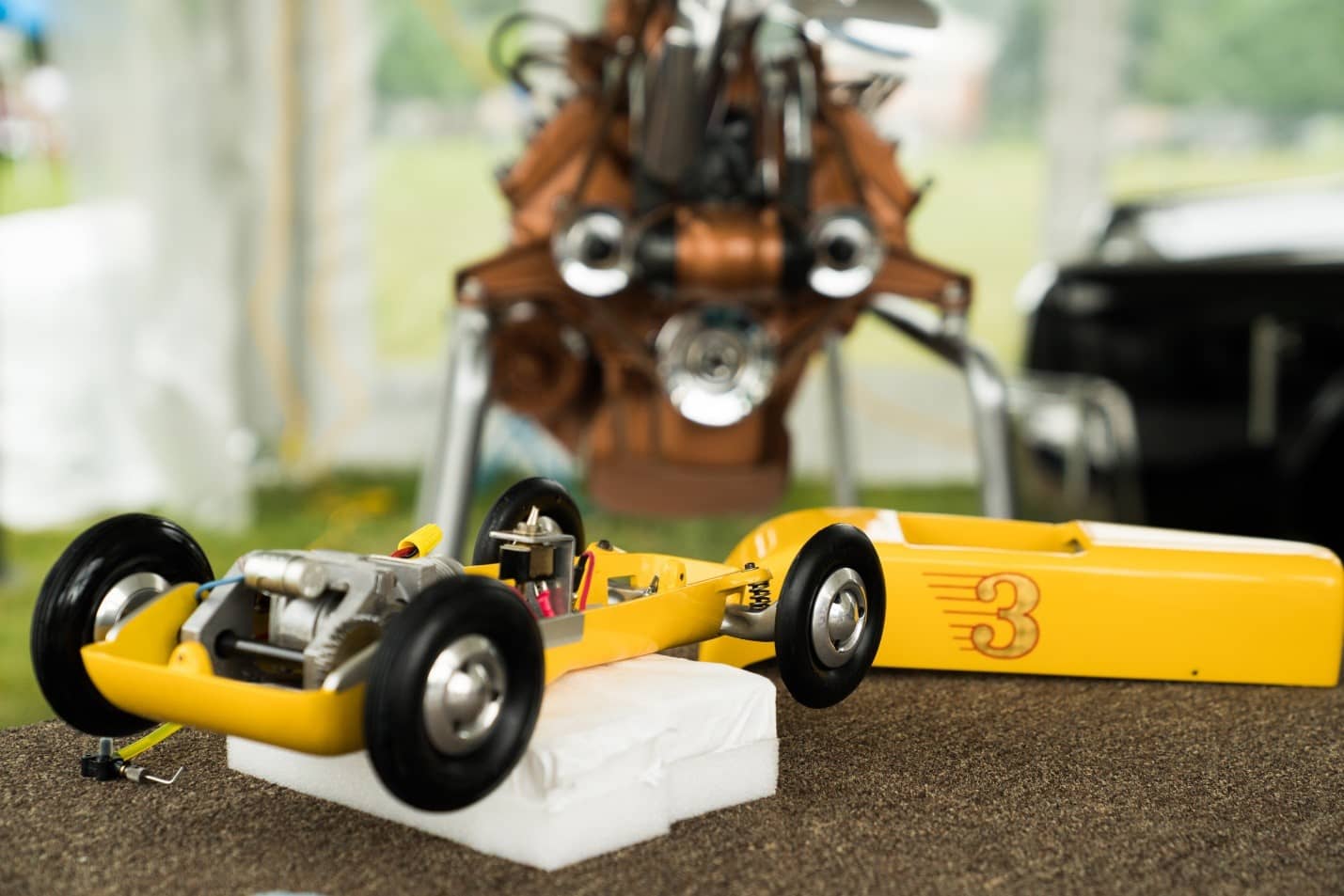 Tether cars peaked in popularity in the years surrounding World War II, though newer models – like this 1990s example – continue to be built by enthusiasts.
Tether cars peaked in popularity in the years surrounding World War II, though newer models – like this 1990s example – continue to be built by enthusiasts.
We added a small-scale surprise to the tent this year. Throughout the weekend, visitors could watch our conservators at work on a gasoline-powered tether car. These miniature racers competed against the clock while tethered to a central pivot, or against each other on scaled-down board tracks. The featured car was one of dozens acquired by The Henry Ford from the E-Z Spindizzy Foundation in 2013.
Scenes from the World War II home front came to life at our small-town War Bond drive.
Building on the “historical vignette” concept that debuted at last year’s Old Car Festival, this year’s Motor Muster included period settings for each decade represented by the cars in the show. For the 1930s, we staged a Civilian Conservation Corps camp at the McGuffey School. For the 1940s, we reenacted a home front War Bond drive, circa 1943, along Washington Boulevard. (In keeping with the theme, Spam sandwiches were available for lunch!)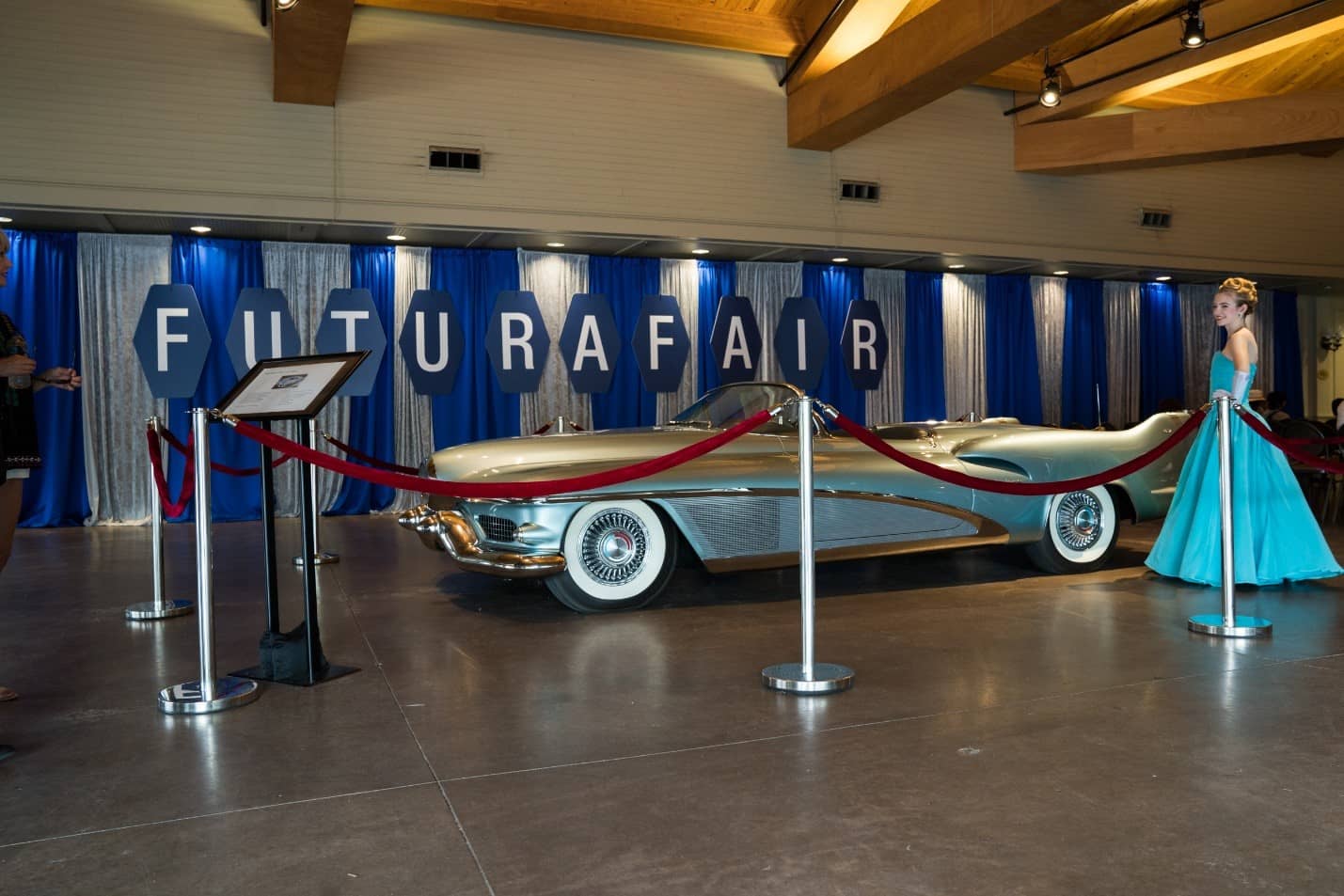
The 1951 General Motors Le Sabre concept car, on loan courtesy of our friends at GM, was a highlight of the “FuturaFair” auto show vignette. GM also provided the 1958 Firebird III.
The 1950s were represented by a Motorama-style auto show in the Village Pavilion. Our “FuturaFair” display included three of that decade’s notable concept cars: the 1951 GM Le Sabre, the 1953 Ford X-100, and the 1958 GM Firebird III. At the Scotch Settlement School, a happy group of revelers enjoyed a suburban-style picnic set in the 1960s. And the Spirit of ’76 reigned at the foot of the Ackley Covered Bridge, where the 1st Michigan Fife & Drum Corps and the Plymouth Fife & Drum Corps performed Bicentennial-themed concerts throughout the weekend.
Badminton kept our Bicentennial vignette lively, while mid-1970s AMC wagons and cars provided atmosphere.
If just looking at cars wasn’t enough, visitors could learn about them either by watching our narrated Pass-in-Review programs at the Main Street grandstand, or by sitting in on one of several presentations in the Village Pavilion. Topics included everything from Ford factory paint methods to the lasting impact of the Chevrolet Corvair. Of course, you could also learn simply by asking the owners about their cars. They enjoy sharing share their stories: where they found the car, why they bought it, and why they love the hobby.
It was another magical weekend filled with good friends, good food, and hundreds of vintage vehicles. And for our 2018 Motor Muster award recipients, it was a winning weekend as well. What better way to welcome another summer?
Matt Anderson is Curator of Transportation at The Henry Ford.
Michigan, Dearborn, 21st century, 2010s, Motor Muster, Greenfield Village, events, engines, cars, car shows, by Matt Anderson
Auto Shows
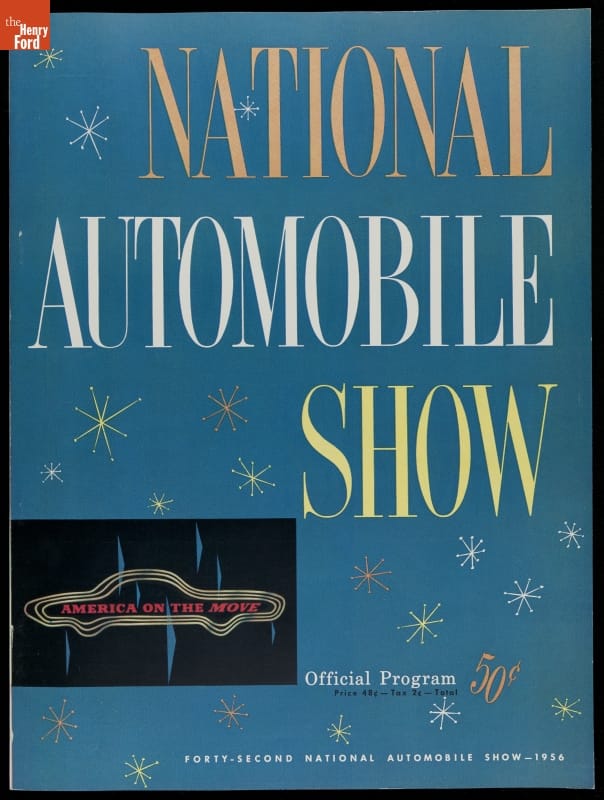
National Automobile Show Official Program, 1956. THF206474
A big city auto show is a magical place. Automakers turn heads and grab headlines with futuristic concept cars and the latest production models. Suppliers and aftermarket vendors mount elaborate displays promoting everything from gearboxes to floor mats. For the public, it’s a chance to do some serious research on that next big car purchase, or to simply dream while gazing at sports cars, luxury sedans and special edition trucks.
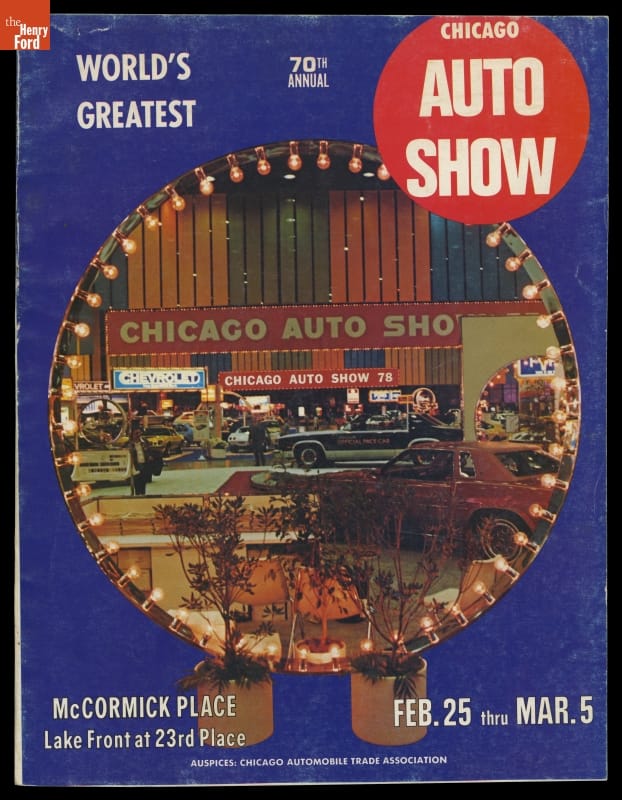
Program, "70th Annual Chicago Auto Show," February 25 through March 5, 1978. THF108058
Auto shows are part trade show and part show business, but they’ve been a part of the automotive industry from the beginning. We’ve put together a new Expert Set featuring programs and posters drawn from the past century. See how much has changed – and how much hasn’t – in selling the American automobile.
Matt Anderson is Curator of Transportation at The Henry Ford.
Concept Cars
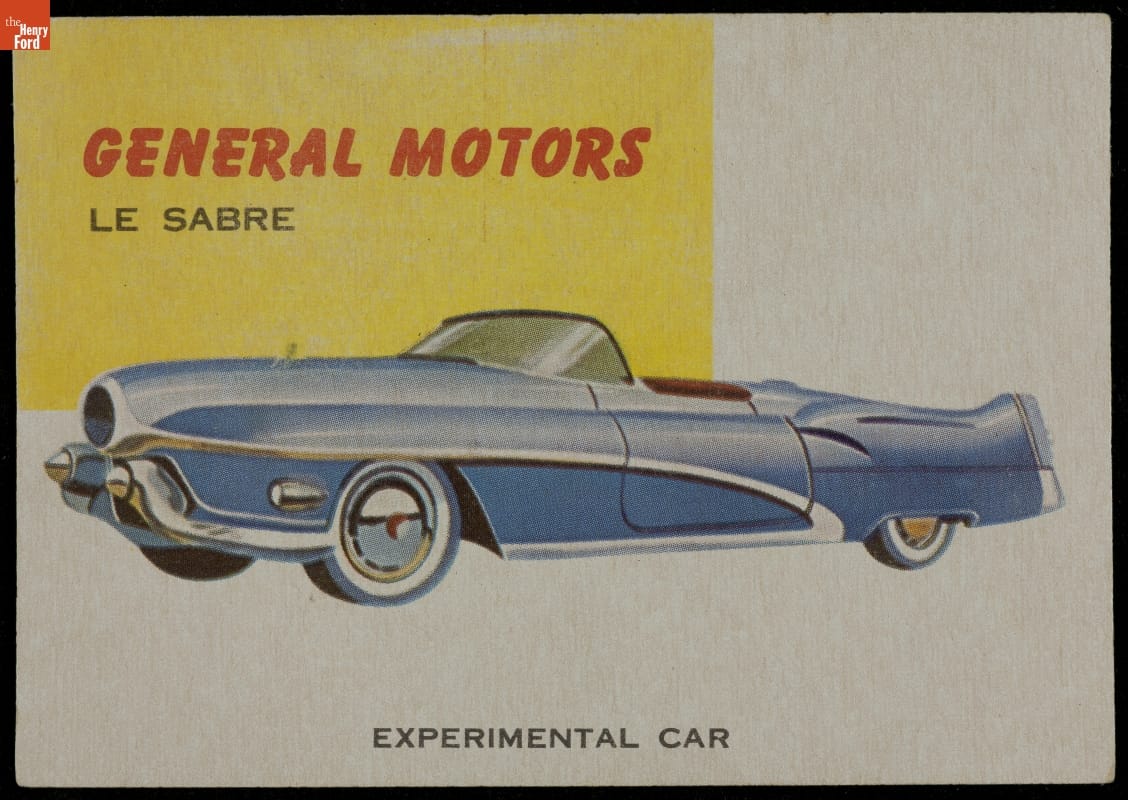
Topps "World on Wheels" Series Collecting Card, circa 1951 General Motors Le Sabre Experimental Car, circa 1954. THF207260
Nothing stirs the imagination like a concept car. These dream vehicles offer a tantalizing glimpse into the future with dramatic styling features and sophisticated technologies that may (or may not) be right around the corner for us everyday drivers. Most concept cars never make it into regular production, though two notable examples – the Chevrolet Corvette and the Dodge Viper – did make the leap from fantasy to reality. (Sadly, my favorite concept car – the 1986 Corvette Indy – did not.)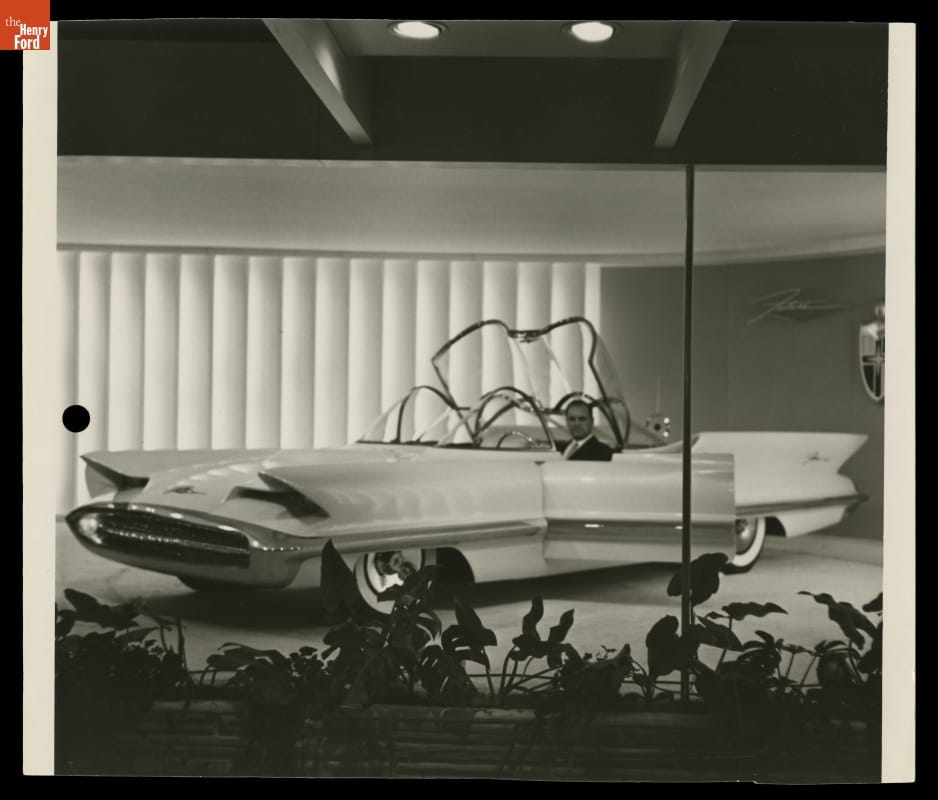
Concept cars are, by nature, ephemeral things. Once they’ve toured enough auto shows and generated enough buzz, they often get scrapped. One, the 1955 Lincoln Futura, went on to even greater glory after it was rebuilt into the Batmobile for the 1966-68 Batman television series. Other lucky vehicles found homes in museums.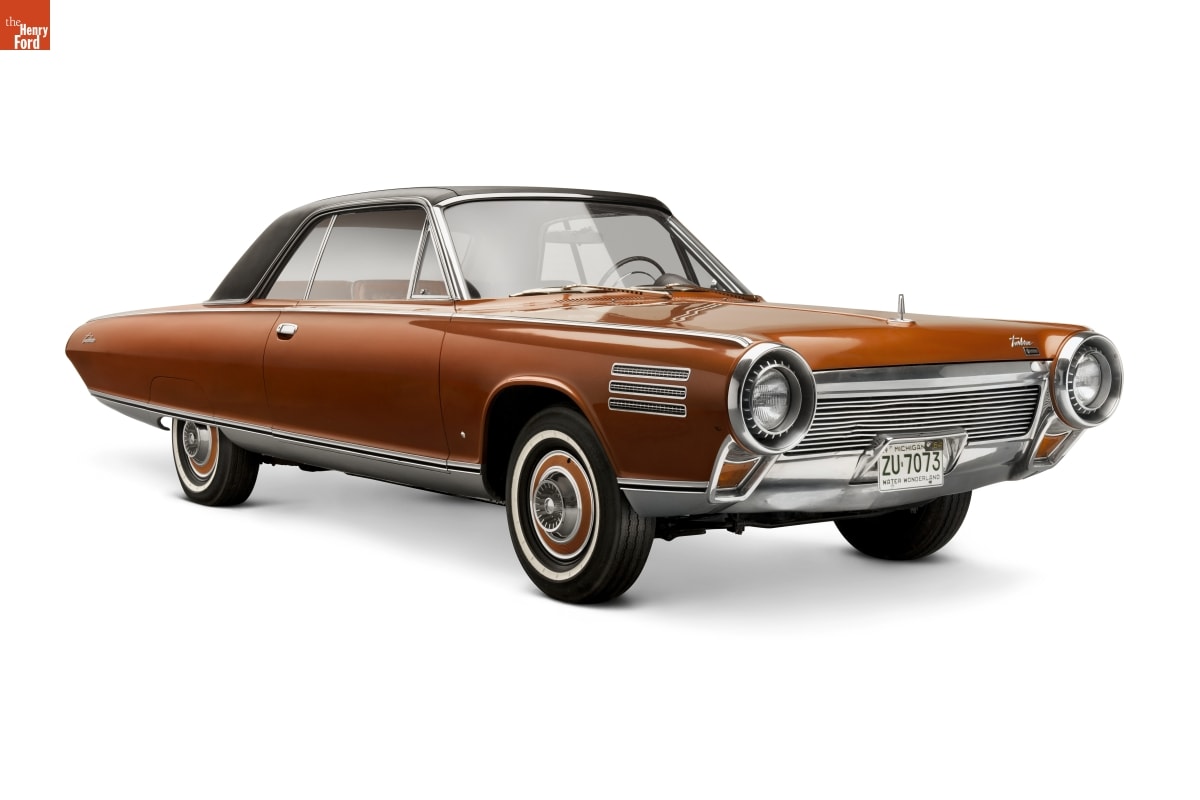
The Henry Ford has several concept cars in its collection, ranging from the sheltering Cornell-Liberty Safety Car to the shimmering Chrysler Turbine. We’ve pulled together cars, models and promotional materials in a new Expert Set celebrating these fantastic dream machines. Take a look and wish away!
Matt Anderson is Curator of Transportation at The Henry Ford.
A Significant Car on an Important Roster
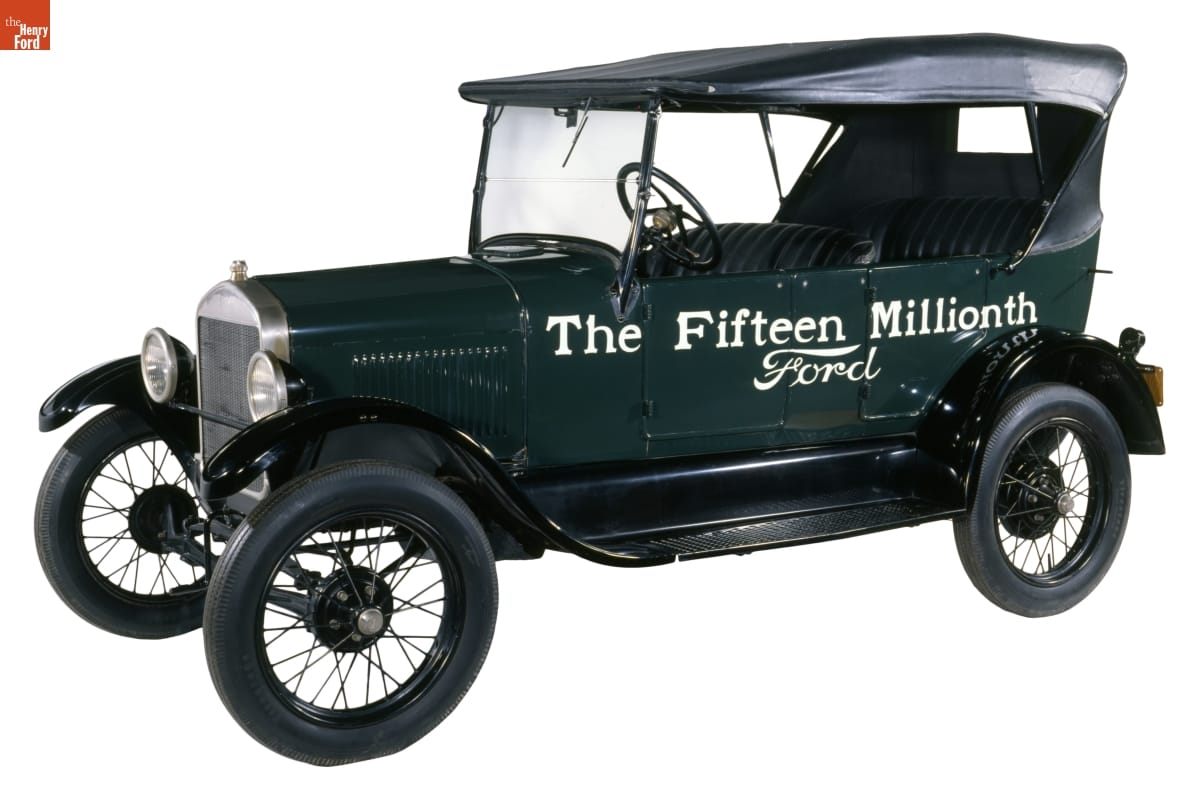
1927 Ford Model T Touring Car, The Fifteen-Millionth Ford. THF135450
Beginning today through April 9 we're honored to have our 1927 Ford Model T Touring Car, the fifteen-millionth Ford, on view at the National Mall for the 2018 Cars at the Capital event. The Historic Vehicle Association has selected our T for inclusion on its National Historic Vehicle Association Register. The 15 Millionth Model T joins impressive roster this year; other vehicles being added to the list include a 1984 Plymouth Voyager (the first Chrysler Minivan), a 1968 Ford Mustang Fastback (used in the iconic chase scene in the 1968 film Bullitt), a 1985 Modena Spyder California (featured in the 1986 movie Ferris Bueller's Day Off), and a 1918 Cadillac Type 57. 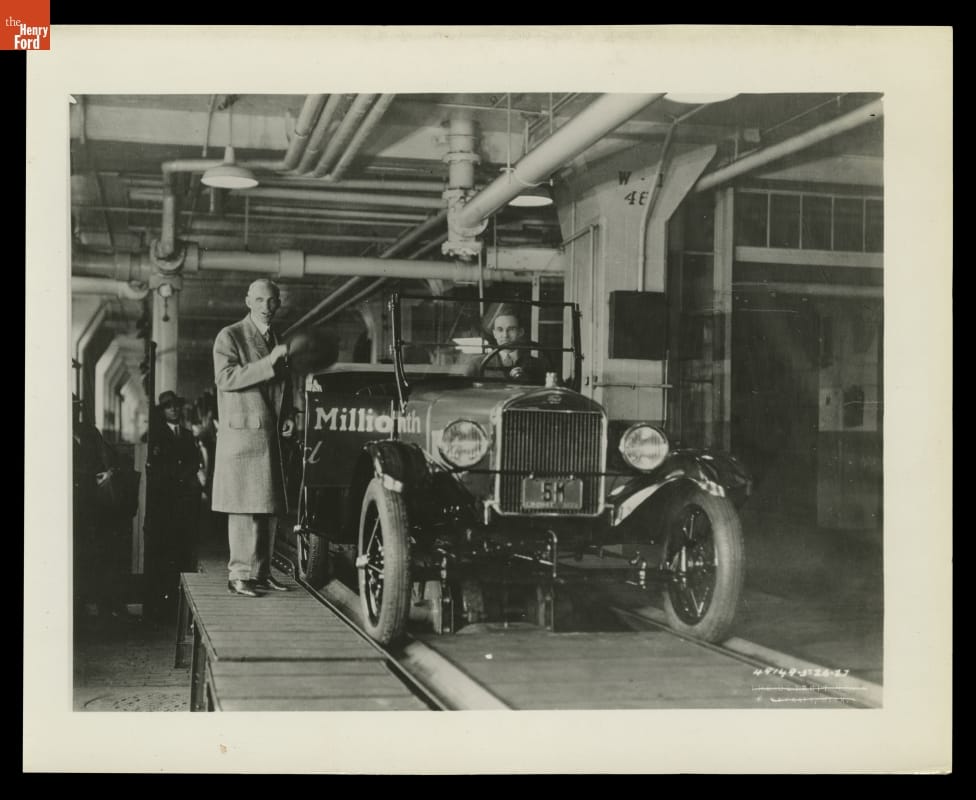
Henry Ford and Edsel Ford with the Fifteen-Millionth Ford Model T on the Last Day of Model T Production, May 26, 1927. THF118798
Although the 1927 Model T looked different from the original 1908 Model T due to many styling changes, the basic elements that made the Model T a technological innovation and cultural phenomenon - a simple 4-cylinder engine, planetary transmission, the limited color choices, and a flexible and strong chassis - were still there but were now liabilities in the automobile market. Consumers were no longer satisfied with a basic, dependable car. Americans demanded faster cars with smoother rides and more amenities. By the mid-1920s, it was obvious to almost everyone at Ford that the Model T's time had passed. Henry Ford, however, retained his firm belief that the Model T was all that anyone would ever need. In an attempt to check declining sales, Ford engineers incrementally modernized the car, introducing options such as electric starters, manually operated windshield wipers and body color choices. (Famously, black as the only color offered from 1914 through 1925.)
None of these ploys, however, allowed the Model T to compete with Chevrolet and Dodge Brothers cars that offered heaters, automated wipers, and a more comfortable ride - all at a comparable price.
When production of the Model T ended in May 1927, Henry Ford's "Universal Car" had introduced the world to the idea of personal mobility and transformed where and how we lived.
Take a look at the car getting ready to head to Washington, D.C., in this video.
cars, Greenfield Village, Henry Ford, by Matt Anderson, Ford Motor Company, Model Ts
Detroit Autorama 2018
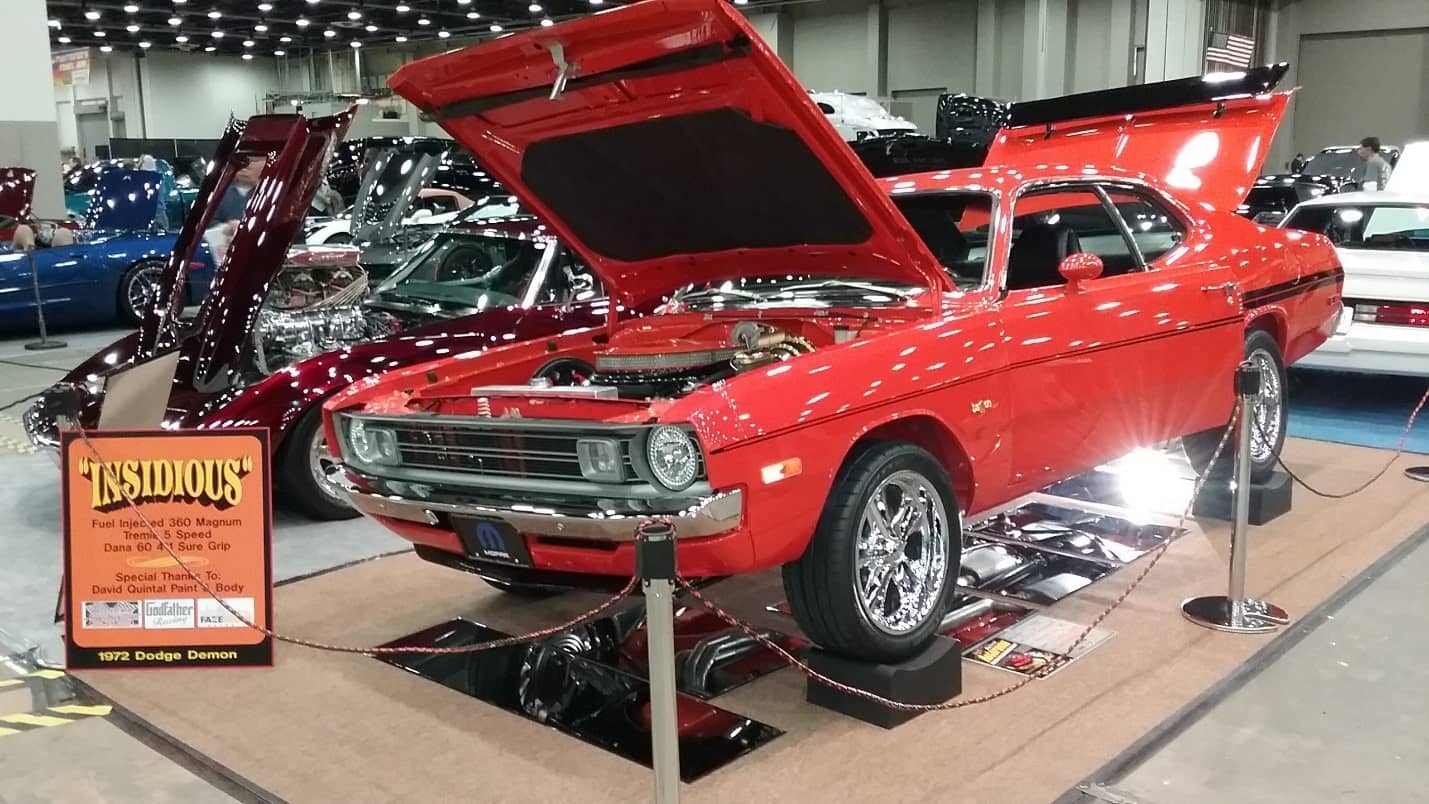 Dodge Demon 1.0: “Insidious,” one of 800 hot rods and custom cars on view at the 2018 Detroit Autorama.
Dodge Demon 1.0: “Insidious,” one of 800 hot rods and custom cars on view at the 2018 Detroit Autorama.There’s still snow on the ground in the Motor City, but car show season is officially underway after the 66th annual Detroit Autorama, held March 2-4. Some of the wildest, weirdest and/or most beautiful customs and hot rods filled Cobo Center in a celebration of chrome and creativity. For those who’ve never been, Autorama is a feast for the eyes (and, at closing time when many of the entrants drive off under their own power, the ears). Some 800 cars, built by the most talented rodders and customizers in the country, are brought together under a single roof to be admired, coveted and judged.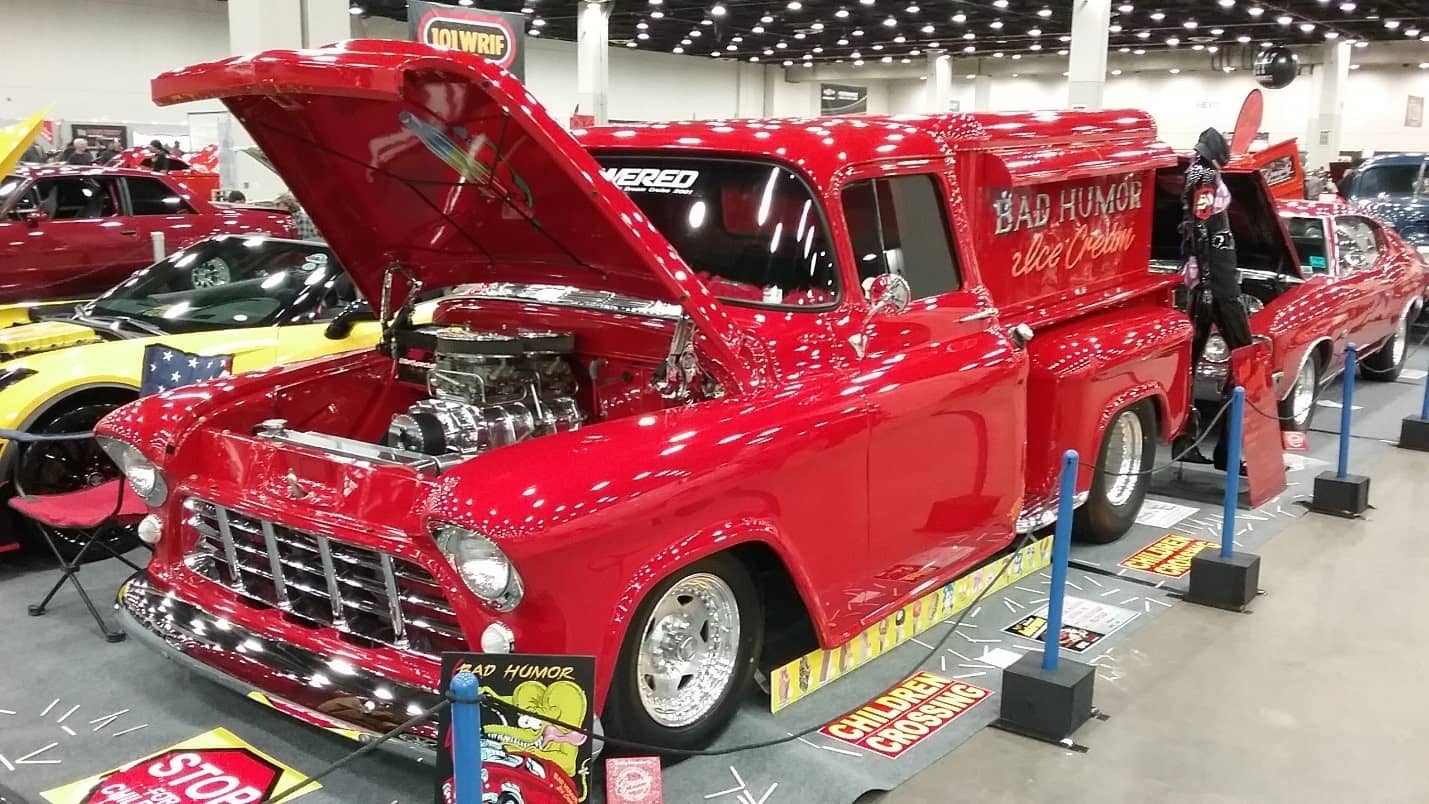 Wit is as much a part of the customizer’s toolbox as wrenches and rachets. Check out this 1955 Chevy “Bad Humor” ice cream truck, surrounded by used popsicle sticks.
Wit is as much a part of the customizer’s toolbox as wrenches and rachets. Check out this 1955 Chevy “Bad Humor” ice cream truck, surrounded by used popsicle sticks.
The most prestigious prize at Autorama is the Ridler Award, named in honor of show promoter Don Ridler. Only cars that have never been shown before are eligible. On Autorama’s opening day, the judges select their “Great 8” – the finalists for the Ridler. Anticipation builds throughout the weekend until the winner is announced at the end of the Sunday afternoon awards presentation. In addition to considerable bragging rights, the Ridler Award winner receives $10,000 and enshrinement in the online Winner Archive. This year’s Ridler went to “Imagine,” a silver 1957 Chevrolet 150 owned by Greg and Judy Hrehovcsik and Johnny Martin of Alamosa, Colorado. Our 2018 Past Forward winner, a 1956 Continental Mark II with a fifth-generation Chevy Camaro powertrain under the body.
Our 2018 Past Forward winner, a 1956 Continental Mark II with a fifth-generation Chevy Camaro powertrain under the body.
Each year The Henry Ford gives out its own prize to a deserving Autorama participant. Our Past Forward award recognizes a car that 1.) Blends custom and hot rod traditions with modern innovation, 2.) Exhibits a high level of craftsmanship, 3.) Captures the “anything goes” spirit of the hobby, and 4.) Is just plain fun. Our 2018 winner, a 1956 Continental Mark II owned by Doug Knorr of Traverse City, Michigan, and built by Classic Car Garage of Greenville, Michigan, had all these qualities in the right combination. Everything about the car said “Continental,” only more so – from the oversized turbine wheels to the elegant Continental star on the valve covers. And if the 400-horsepower LS3 Camaro V-8 under the hood doesn’t say “anything goes,” then I don’t know what does.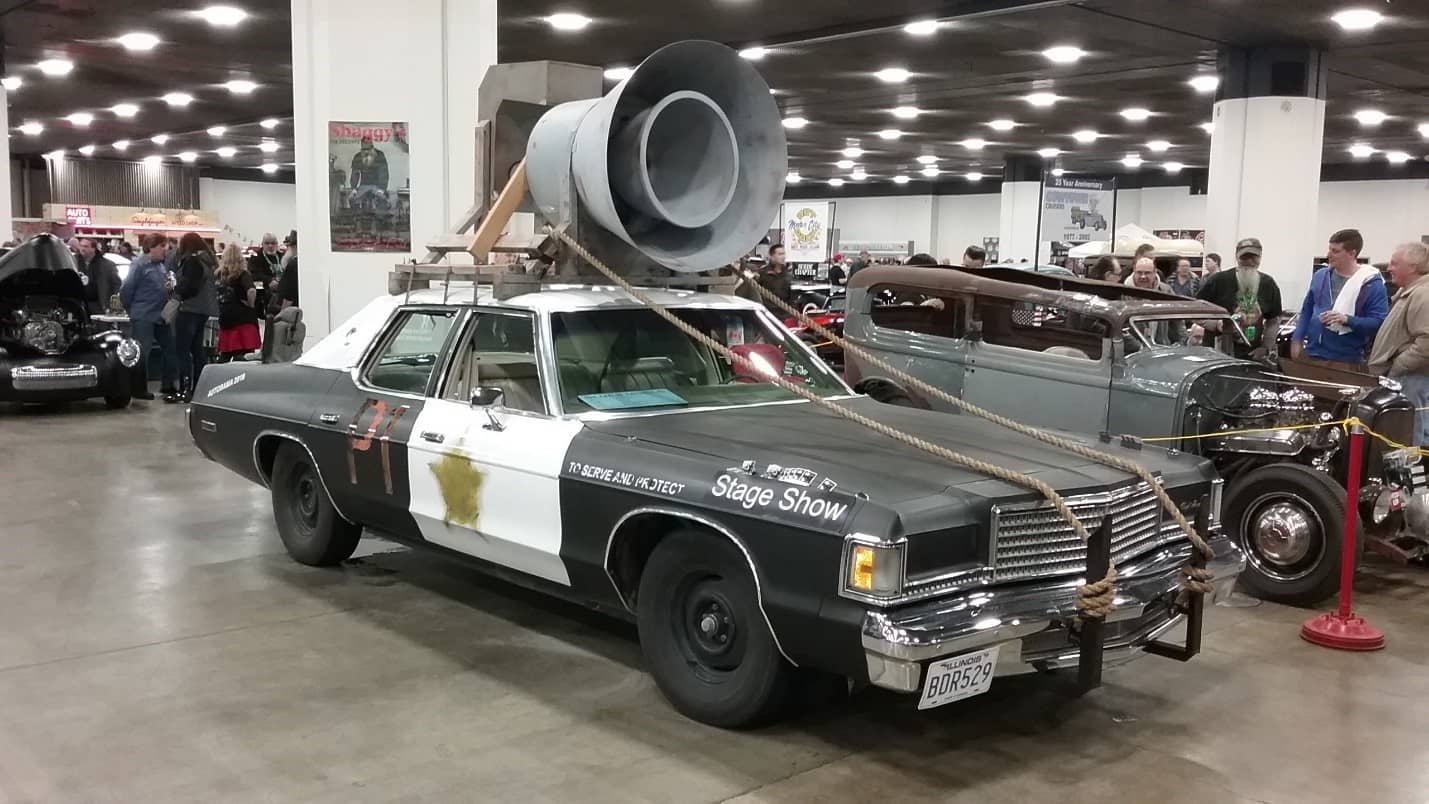 The 1976 Dodge Monaco – notably a model made after catalytic converters, so it won’t run good on regular gas.
The 1976 Dodge Monaco – notably a model made after catalytic converters, so it won’t run good on regular gas.
If chrome-plated undercarriages aren’t your thing, then Autorama Extreme was there for you again this year on Cobo’s lower level. Shammy cloths and car polish are decidedly out of place among the Rat Rods down below. In addition to show cars, vendors and the ever-popular Gene Winfield pop-up chop shop, Autorama Extreme features a concert stage with ongoing musical entertainment. There’s always a healthy dose of 1950s rockabilly on the schedule, but this year’s lineup also included a Blues Brothers tribute act – complete with a 1976 Dodge Monaco gussied up (or down, I suppose) into a fairly convincing copy of the Bluesmobile. Unpolished and proud of it. A 1930 Ford Model A with the Rat Rods in Autorama Extreme.
Unpolished and proud of it. A 1930 Ford Model A with the Rat Rods in Autorama Extreme.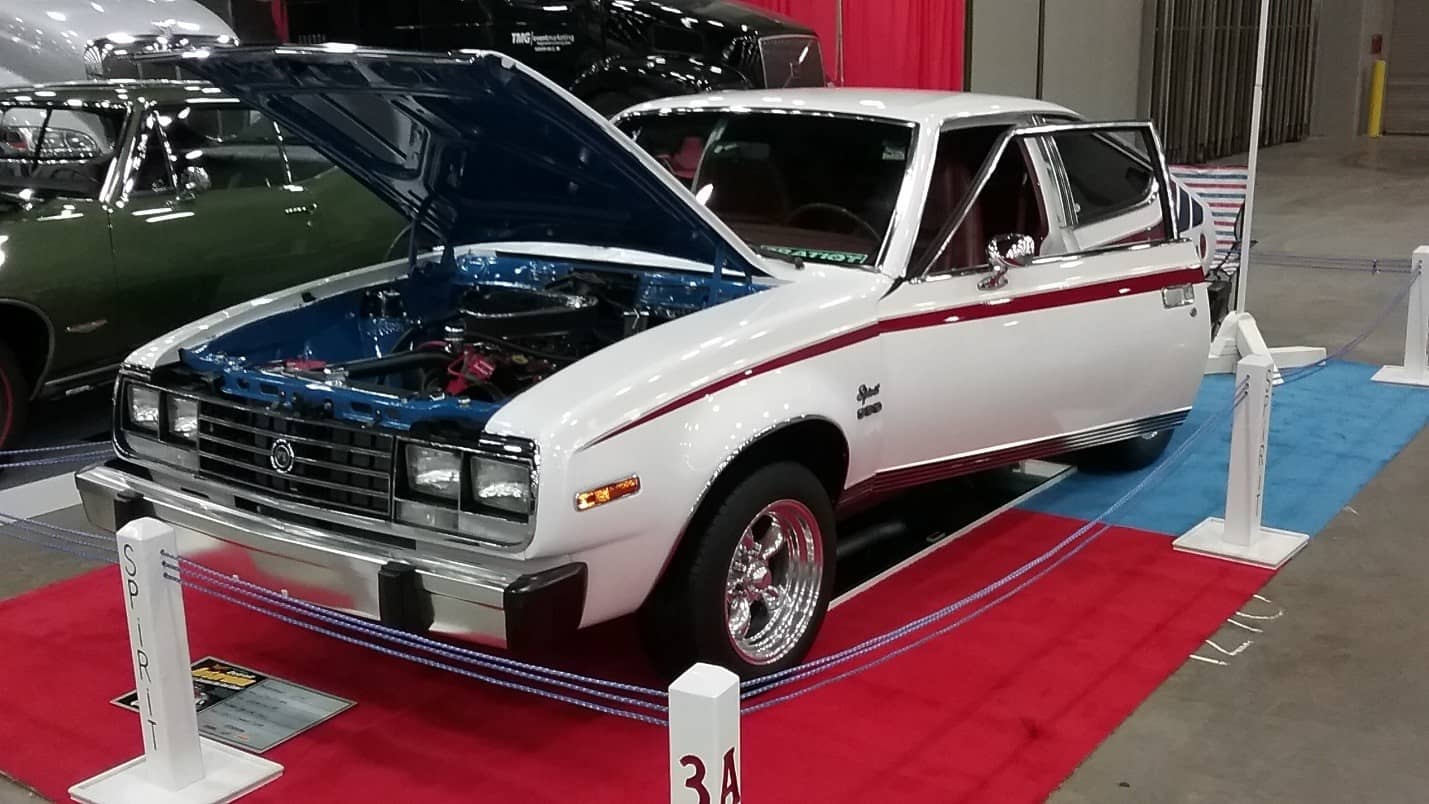 Not everything at Autorama is textbook classic. Here’s a 1980 AMC Spirit patriotically living up to its name with lots of red, white and blue.
Not everything at Autorama is textbook classic. Here’s a 1980 AMC Spirit patriotically living up to its name with lots of red, white and blue.
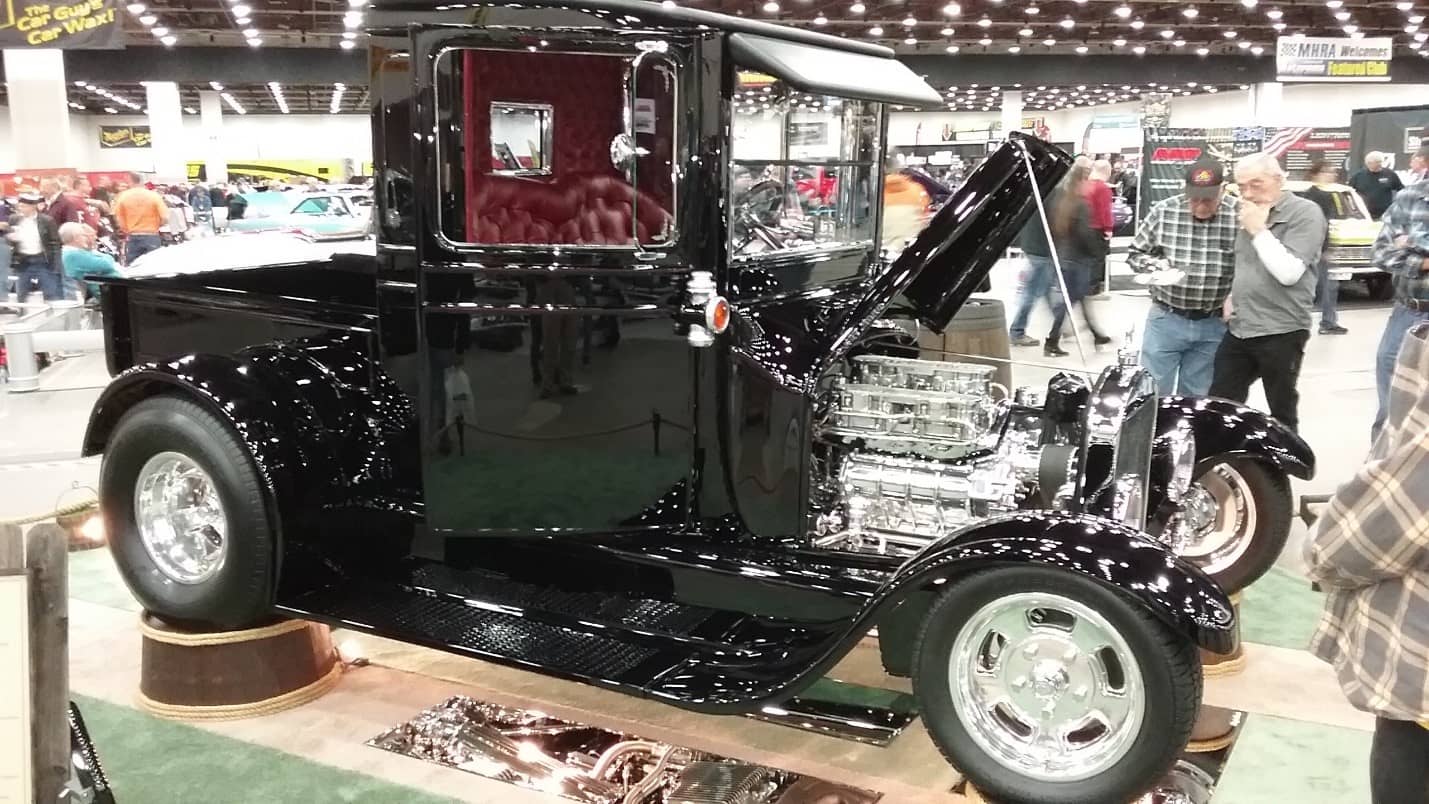 “Lethal T,” for those who’ve always dreamed of putting a 427 Cammer in a Model T.
“Lethal T,” for those who’ve always dreamed of putting a 427 Cammer in a Model T.
If you haven’t been to Detroit Autorama, then make a point of being there in 2019. You won’t find anything quite like it anywhere else in the world.
Matt Anderson is Curator of Transportation at The Henry Ford.
21st century, 2010s, Michigan, Detroit, cars, car shows, by Matt Anderson, Autorama
Report from the 2018 North American International Auto Show
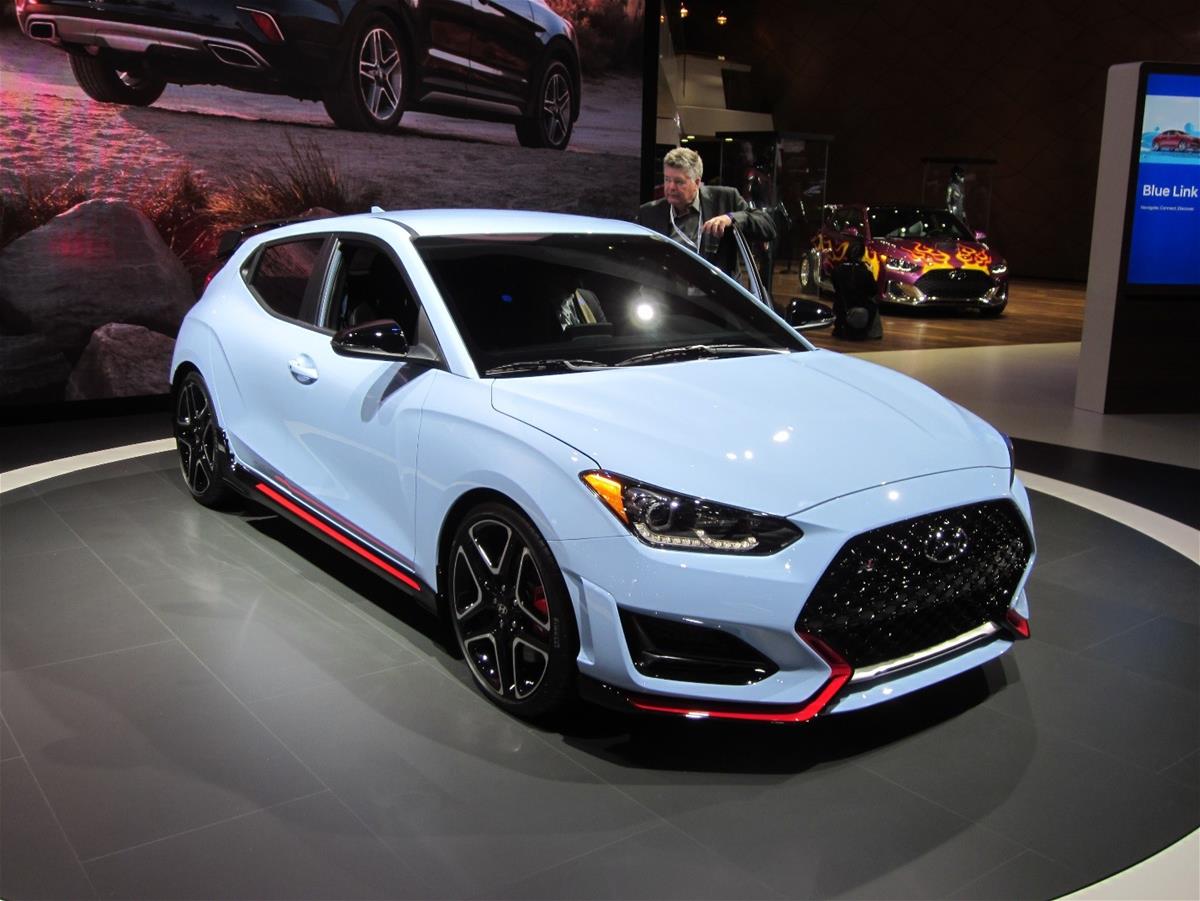
Hot Hatch Heaven! Hyundai’s 275-horsepower Veloster N, one of several new models unveiled at this year’s North American International Auto Show.
Detroit is the capital of the global automotive industry once more as the 2018 North American International Auto Show arrives at Cobo Center. Carmakers from around the world have come to share peeks at their 2019 model lines, and hint at new technologies that may be coming in the years ahead. As usual, the exhibits range from exciting, to informative to downright unreal.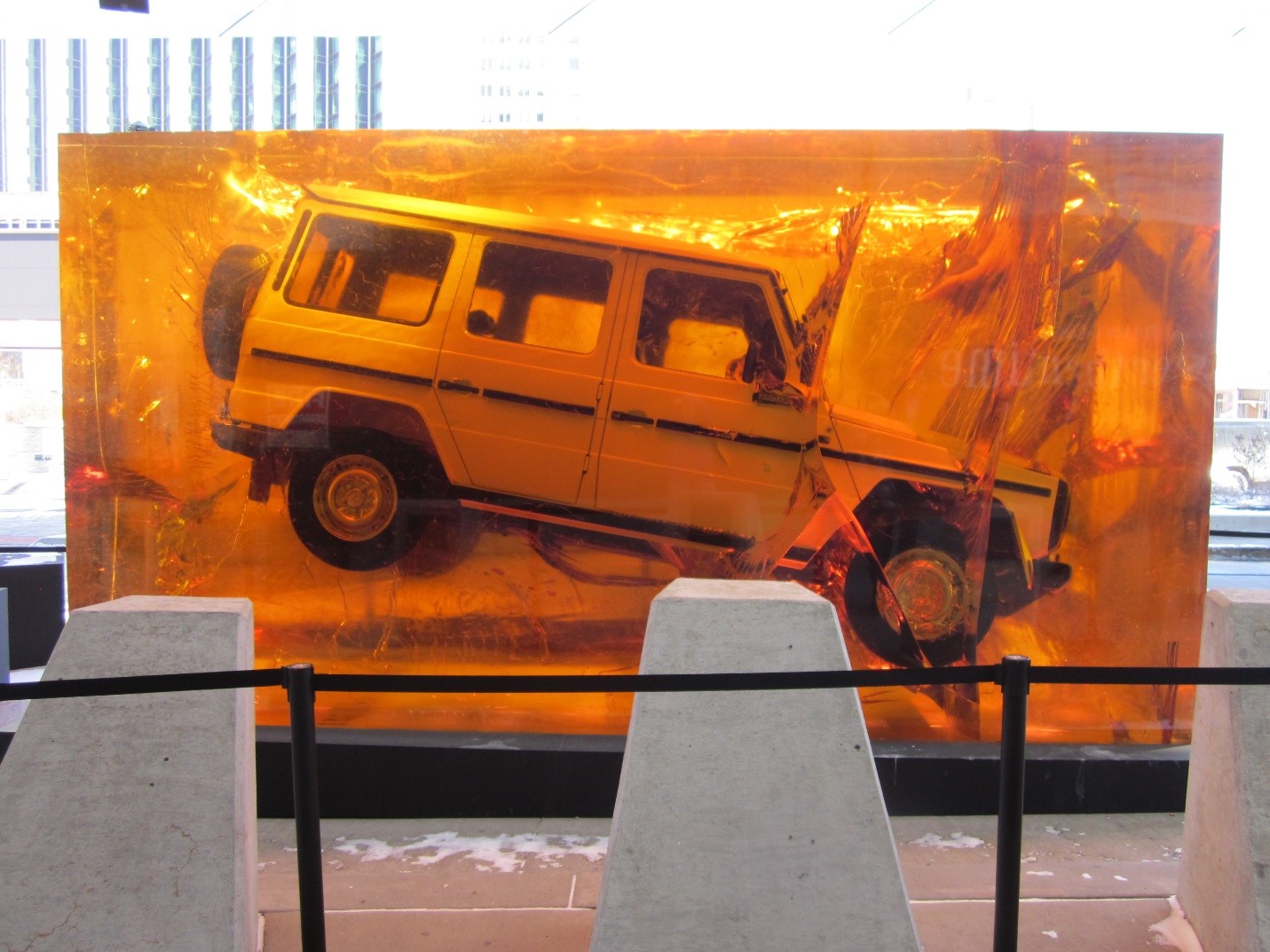 This is exactly what it looks like: a 1979 Mercedes-Benz G-Class frozen in amber.
This is exactly what it looks like: a 1979 Mercedes-Benz G-Class frozen in amber.
Mercedes-Benz takes the cake for most unusual display. The German automaker unveiled a new version of its venerable G-Class SUV, in continuous production since 1979. To emphasize its endurance, Mercedes encased a vintage G-Class in a giant block of amber. (Think dino-DNA mosquitoes in Jurassic Park.) The block is located outside, along Washington Boulevard, rather than in the Mercedes-Benz booth. But don’t miss that either – you can see a 2019 G-Class splattered with faux mud, and the G-Class driven to victory by Jacky Ickx and Claude Brasseur in the 1983 Paris-Dakar Rally.
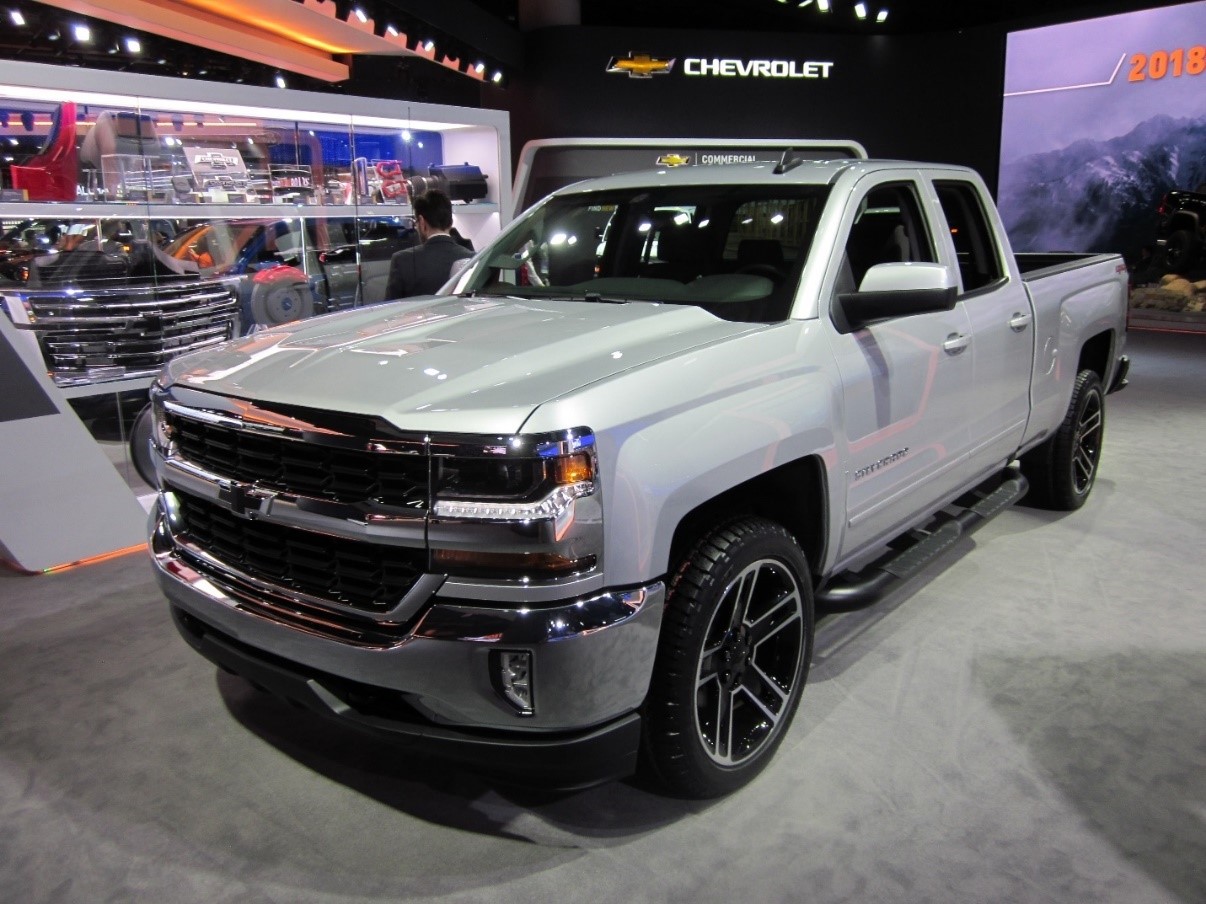 The Chevrolet Silverado – now lighter thanks to a blend of steel and aluminum body panels.
The Chevrolet Silverado – now lighter thanks to a blend of steel and aluminum body panels.
With gas prices down and the economy up, Americans have reignited their romance with pickup trucks. Chevrolet and Dodge both revealed new full-sized models, while Ford trumpeted the return of its mid-size Ranger. The 2019 Chevy Silverado rolled out under the headline “mixed materials.” In response to the Ford F-150’s aluminum bed (premiered at 2014’s NAIAS) and fuel efficiency targets, the bowtie brand is now building Silverado bodies with a mix of steel and aluminum components, shedding some 450 pounds from the truck’s overall weight. Chevy, celebrating a century in the truck business this year, is quick to point out that Silverado’s bed remains an all-steel affair. (Silverado TV commercials have been cutting on the F-150’s aluminum bed for some time now.)
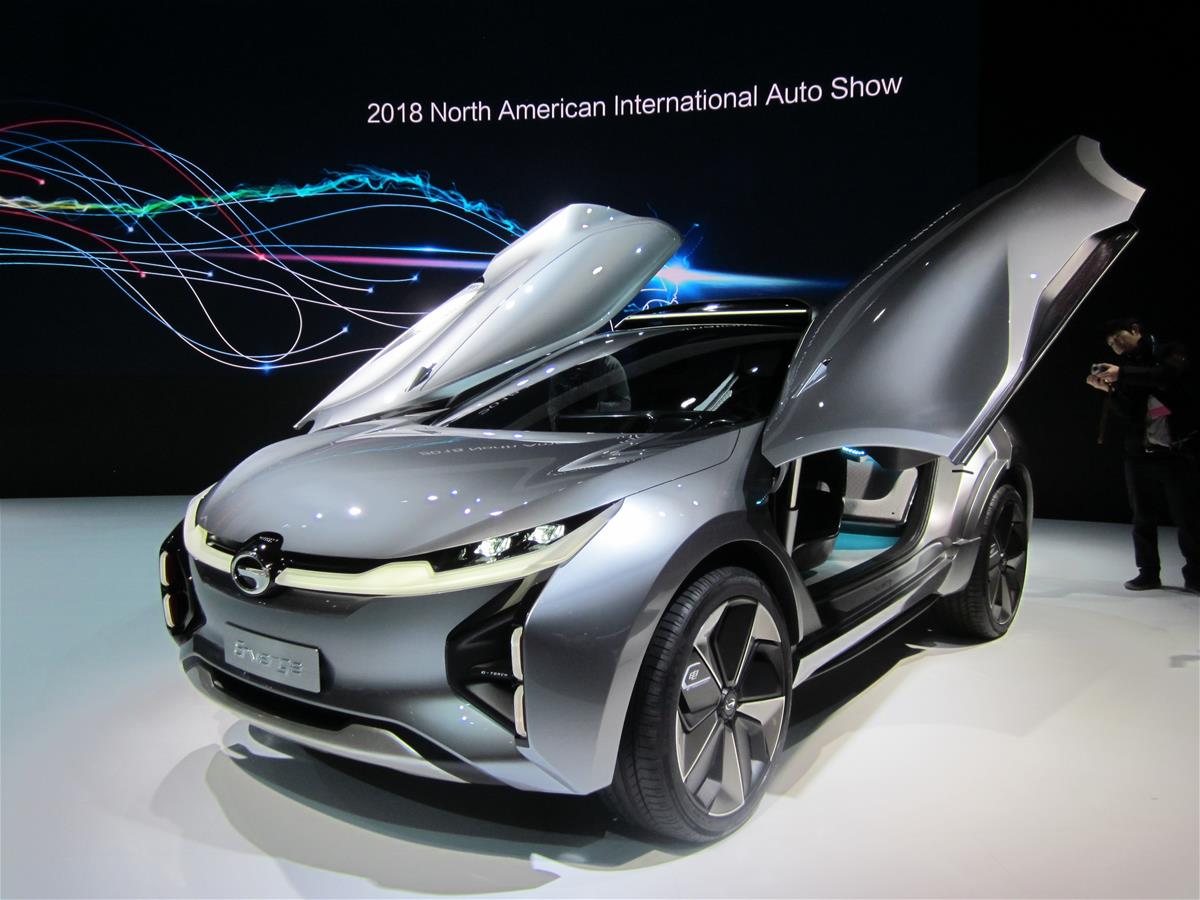 Eyeing the American market, China’s GAC Motor makes a splash with its Enverge concept car.
Eyeing the American market, China’s GAC Motor makes a splash with its Enverge concept car.
China is a bigger factor in the American auto industry each year. Buick’s Envision crossover is already made in China, and Ford will shift production of its compact Focus there next year. It’s only a matter of time before a Chinese automaker starts marketing cars in the United States. GAC Motor hopes to be the first, announcing plans to sell vehicles stateside in 2019. (Yes, Chinese-owned Volvo is already selling cars here, but it first came to the U.S. in 1955 in its original Swedish guise.) It could be a tough sell – U.S. automakers and politicians aren’t too pleased with the steep tariffs imposed on American cars sent to China. In the meantime, GAC tempts NAIAS visitors with its Enverge concept SUV. The all-electric Enverge is said to have a range of 370 miles on a single charge – and can be recharged for a range of 240 miles in a mere 10 minutes.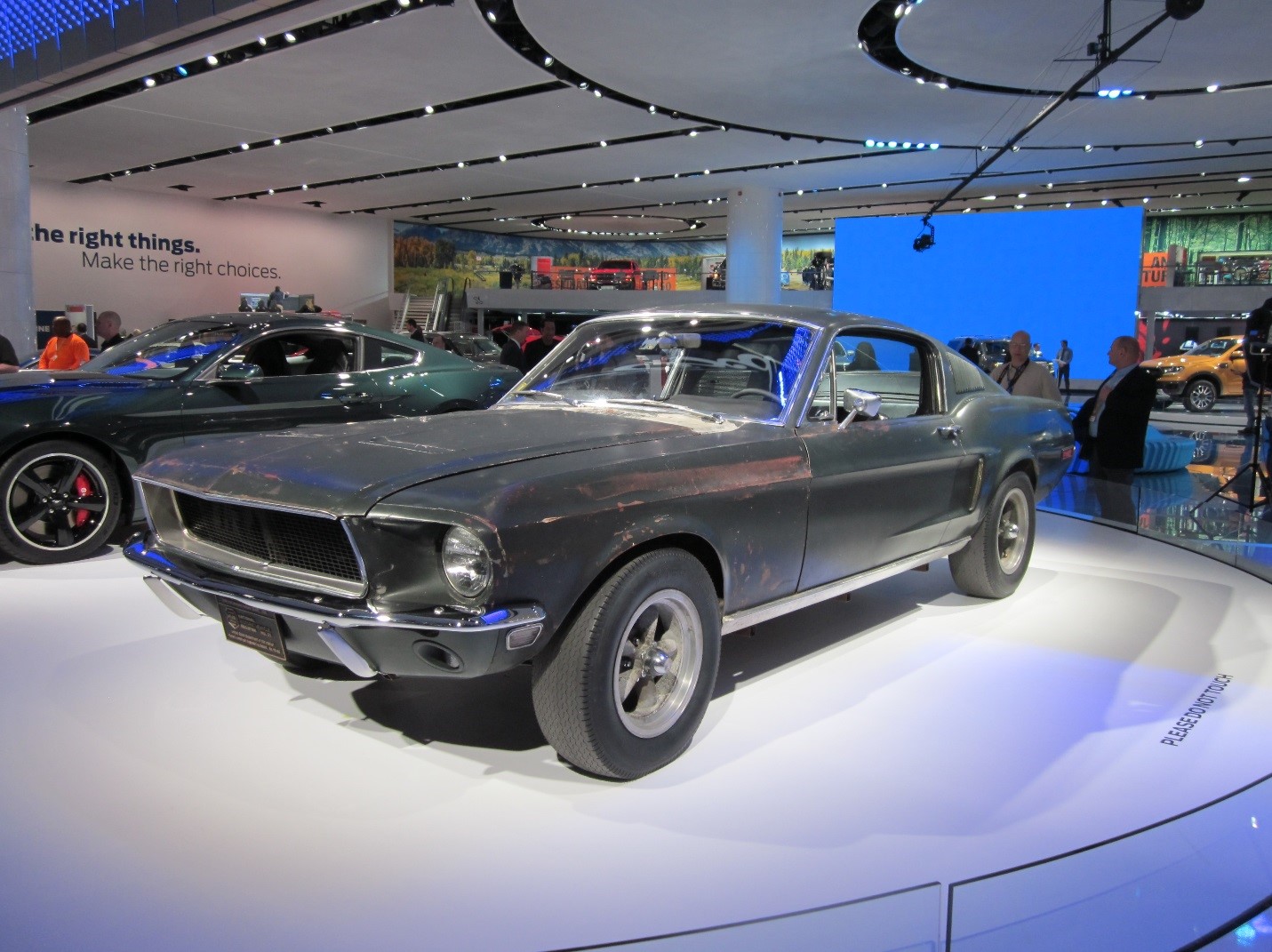
Detective Frank Bullitt’s 1968 Ford Mustang, among Hollywood’s most iconic cars.
Ironically, one of the most talked-about cars at NAIAS is 50 years old. Ford Motor Company tracked down one of two Highland Green Mustangs driven by Steve McQueen in the 1968 thriller Bullitt. As any gearhead knows, the movie’s epic 11-minute chase scene, in which McQueen and his Mustang go toe-to-toe with a couple of baddies in a black 1968 Dodge Charger, is considered one of Hollywood’s all-time greatest car chases – even half a century later. Its lasting appeal is a credit to McQueen’s skill (both as an actor and a driver – he did some of the chase driving himself), the “you are there” feel of the in-car camerawork, and – obviously – the total absence of CGI. Those are real cars trading real paint.
The current owner’s parents bought the Mustang through a 1974 classified ad in Road & Track magazine. For years they used one of pop culture’s most important automobiles as their daily driver! With the movie’s 50th anniversary this year, the owner decided it was time to bring the car back into the spotlight. Ford agreed and, in addition to the movie car, its booth also features the limited edition 2019 Bullitt Mustang, a tribute car that hits dealer lots this summer.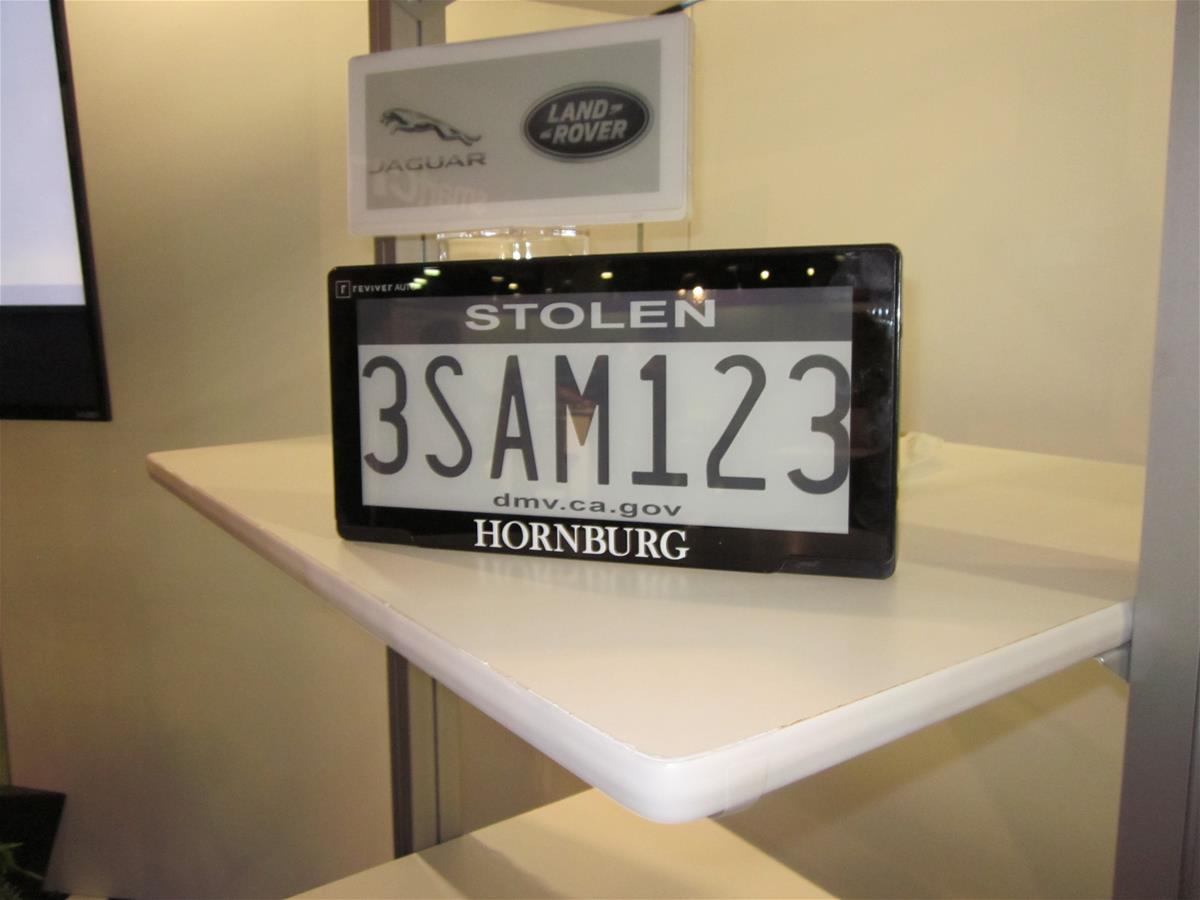
Digital license plates may one day eliminate sticker tabs – or be remotely updated to alert police of a stolen vehicle.
The youngest, hungriest companies at NAIAS are on Cobo Center’s lower level. More than 50 start-ups, along with colleges and government agencies, are in Detroit for the second annual AutoMobili-D, the showcase for fresh ideas and innovative technologies. Reviver Auto hopes to revolutionize an accessory that hasn’t changed in more than a century: the license plate. The California company proposes swapping the tried and true stamped metal plate for a digital screen. The new device is more visible in low light and poor weather, and resistant to the corrosion that plagues metal plates. In lieu of adhesive registration tabs, your digital plate could be renewed remotely each year by the DMV. Plates could also broadcast Amber Alerts to other drivers, or be updated by authorities if you report your car as stolen. Some will argue that current license plates are fine – as functional and intuitive as need be. But based on the number of randomly-placed renewal tabs I see out there, I’m not so sure there isn’t room for improvement.
Matt Anderson is Curator of Transportation at The Henry Ford.
21st century, 2010s, technology, NAIAS, movies, Michigan, Detroit, cars, car shows, by Matt Anderson
Remembering Dan Gurney (1931-2018)
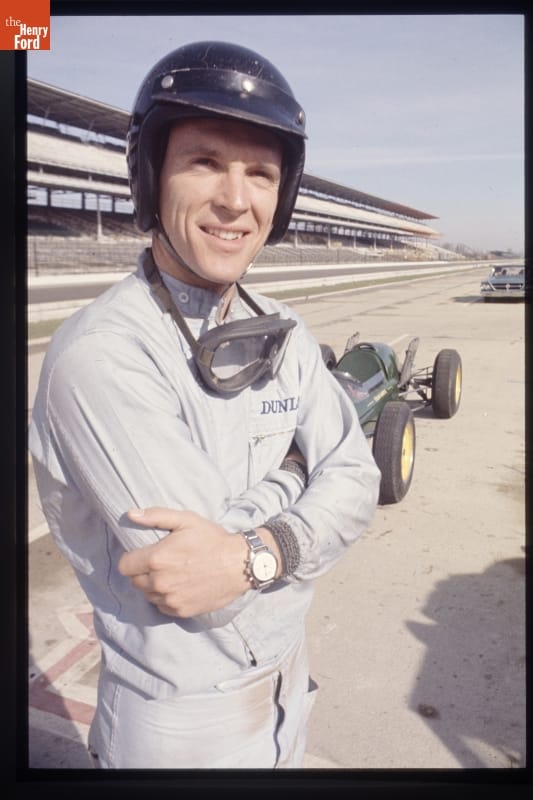
Dan Gurney at Indianapolis Motor Speedway, 1963. THF114611
The Henry Ford is deeply saddened by the loss of a man who was both an inspiration and a friend to our organization for many years, Dan Gurney.
Mr. Gurney’s story began on Long Island, New York, where he was born on April 13, 1931. His father, John Gurney, was a singer with the Metropolitan Opera, while his grandfather, Frederic Gurney, designed and manufactured a series of innovative ball bearings.
The Gurneys moved west to Riverside, California, shortly after Dan graduated high school. For the car-obsessed teenager, Southern California was a paradise on Earth. He was soon building hot rods and racing on the amateur circuit before spending two years with the Army during the Korean War.
Following his service, Gurney started racing professionally. He finished second in the Riverside Grand Prix and made his first appearance at Le Mans in 1958, and earned a spot on Ferrari’s Formula One team the following year. Through the 1960s, Gurney developed a reputation as America’s most versatile driver, earning victories in Grand Prix, Indy Car, NASCAR and Sports Car events.
His efforts with Ford Motor Company became the stuff of legend. It was Dan Gurney who, in 1962, brought British race car builder Colin Chapman to Ford’s racing program. Gurney saw first-hand the success enjoyed by Chapman’s lithe, rear-engine cars in Formula One, and he was certain they could revolutionize the Indianapolis 500 – still dominated by heavy, front-engine roadsters. Jim Clark proved Gurney’s vision in 1965, winning Indy with a Lotus chassis powered by a rear-mounted Ford V-8. Clark’s victory reshaped the face of America’s most celebrated motor race.
Simultaneous with Ford’s efforts at Indianapolis, the Blue Oval was locked in its epic battle with Ferrari at the 24 Hours of Le Mans. Again, Dan Gurney was on the front lines. While his 1966 race, with Jerry Grant in a Ford GT40 Mark II, ended early with a failed radiator, the next year brought one of Gurney’s greatest victories. He and A.J. Foyt, co-piloting a Ford Mark IV, finished more than 30 miles ahead of the second-place Ferrari. It was the first (and, to date, only) all-American victory at the French endurance race – American drivers in an American car fielded by an American team. Gurney was so caught up in the excitement that he shook his celebratory champagne and sprayed it all over the crowd – the start of a victory tradition.
Just days after the 1967 Le Mans, Gurney earned yet another of his greatest victories when he won the Belgian Grand Prix in an Eagle car built by his own All American Racers. It was another singular achievement. To date, Gurney remains the only American driver to win a Formula One Grand Prix in a car of his own construction.
Dan Gurney retired from competitive driving in 1970, but remained active as a constructor and a team owner. His signature engineering achievement, the Gurney Flap, came in 1971. The small tab, added to the trailing edge of a spoiler or wing, increases downforce – and traction – on a car. Gurney flaps are found today not only on racing cars, but on helicopters and airplanes, too. In 1980, Gurney’s All American Racers built the first rolling-road wind tunnel in the United States. He introduced his low-slung Alligator motorcycle in 2002 and, ten years after that, the radical DeltaWing car, which boasted half the weight and half the drag of a conventional race car. Never one to settle down, Gurney and his team most recently were at work on a moment-canceling two-cylinder engine that promised smoother, more reliable operation than conventional power plants.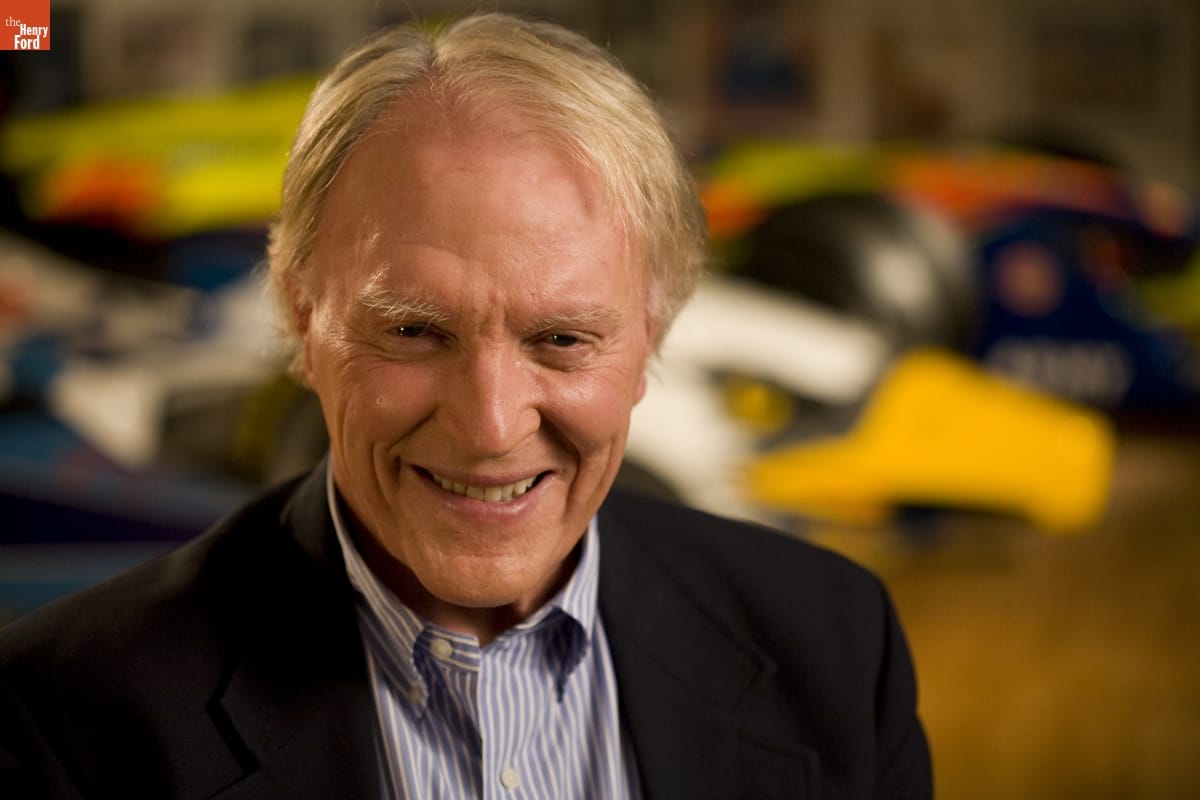 Dan Gurney, 2008. THF56228
Dan Gurney, 2008. THF56228
Our admiration for Mr. Gurney at The Henry Ford is deep and longstanding. In 2014, he became only the second winner of our Edison-Ford Medal for Innovation. It was a fitting honor for a man who brought so much to motorsport, and who remains so indelibly tied to The Henry Ford’s automotive collection. Cars like the Ford Mark IV, the Mustang I, the Lotus-Ford, and even the 1968 Mercury Cougar XR7-G (which he endorsed for Ford, hence the “G” in the model name), all have direct links to Mr. Gurney.
We are so very grateful for the rich and enduring legacy Dan Gurney leaves behind. His spirit, determination and accomplishments will continue to inspire for generations to come.
Hear Mr. Gurney describe his career and accomplishments in his own words at our “Visionaries on Innovation” page here.
View the film made to honor Mr. Gurney at his Edison-Ford Medal ceremony below.
engineering, Mark IV, Indy 500, Le Mans, Europe, Indiana, California, New York, 21st century, 20th century, racing, race cars, race car drivers, in memoriam, Henry Ford Museum, Driven to Win, cars, by Matt Anderson
Highlights from CES 2018
Every January, the tech world descends upon Las Vegas for the Consumer Electronics Show. In 2018, over 4000 global companies displayed their products and ideas, spread throughout 2.6 million square feet of exhibition space in the Las Vegas Convention Center and ten hotels. Nearly 185,000 industry professionals, exhibitors, and media from around the world attended this year. By the numbers, it is an impressive event.
Many successful home technologies have made their debut at CES over its 51-year run: VCRs, camcorders, CD players, DVDs, tablet computers—even the original Nintendo Entertainment System and Xbox. This year’s trends included the forthcoming “5G network,” digital health and fitness, and improved autonomous vehicles. One “battle” visible on the show floor was the widespread adoption of voice-command technology—from smart speakers in the home to command modules in vehicles—and which platform would reign. Ask Alexa. Hey Google. Hi Bixby.
CES has been known to “make or break” companies. Established companies use the event as a forum to launch new products, improve existing devices, or inadvertently—present the occasional flop. Likewise, the 600+ startup companies that populate the specialized “Eureka Park” section angle to find the right pair of eyes on their idea and to secure funding for marketplace production.
Even with two curators on the ground, it was impossible to see everything. What follows is a sampling of our Curator of Communication & Information Technology and our Curator of Transportation’s favorite “CES Moments.” 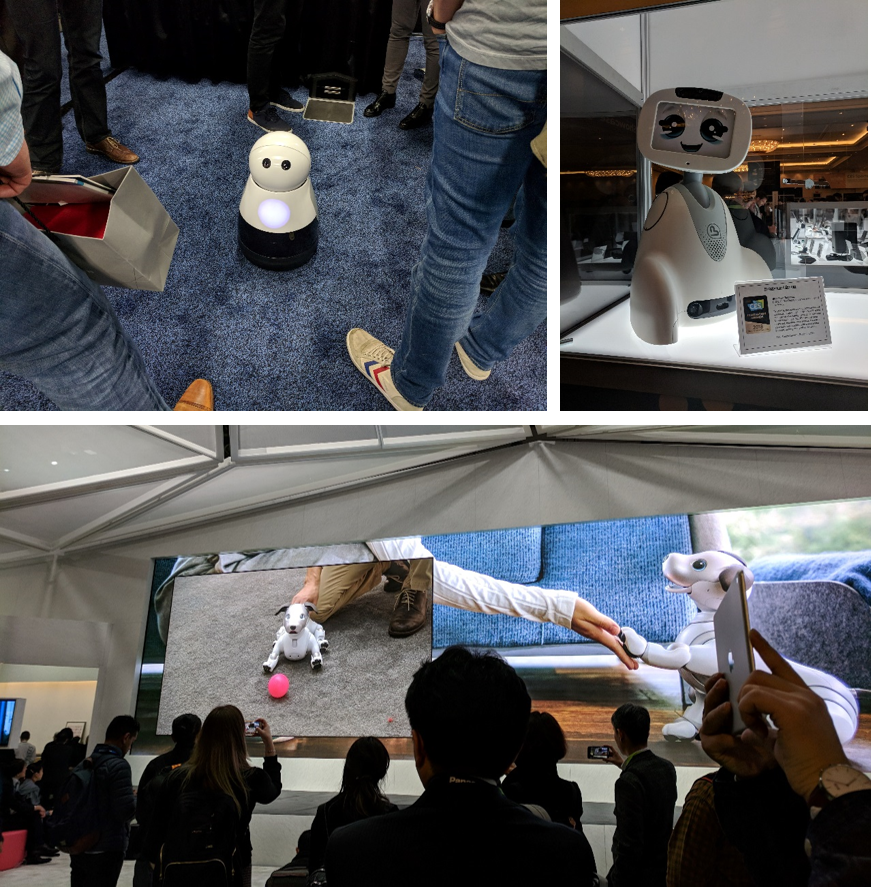
Here come the robots! Some of them can’t be described as anything but “cute,” like this Kuri model (upper left) from Mayfield Robotics. Also popular was Blue Frog’s “Buddy,” (upper right) and Sony’s Aibo the robot dog (bottom). All three of these devices are designed as “companion robots” and have a variety of expressive features. Today’s robots are equipped with facial recognition, cameras for capturing life’s moments, and often double as home security. 
Analog is always new again! The proliferation of quality cellphone cameras and social media has all but locked our memories into digital landscapes. But people remain hungry for physical media and printed photographs. This year at CES, Kodak displayed the Printomatic (right) and Polaroid announced the OneStep 2—an instant camera blending old and new technology (left, middle). The colorful film options and iconic square format should look familiar to today’s Instagrammers.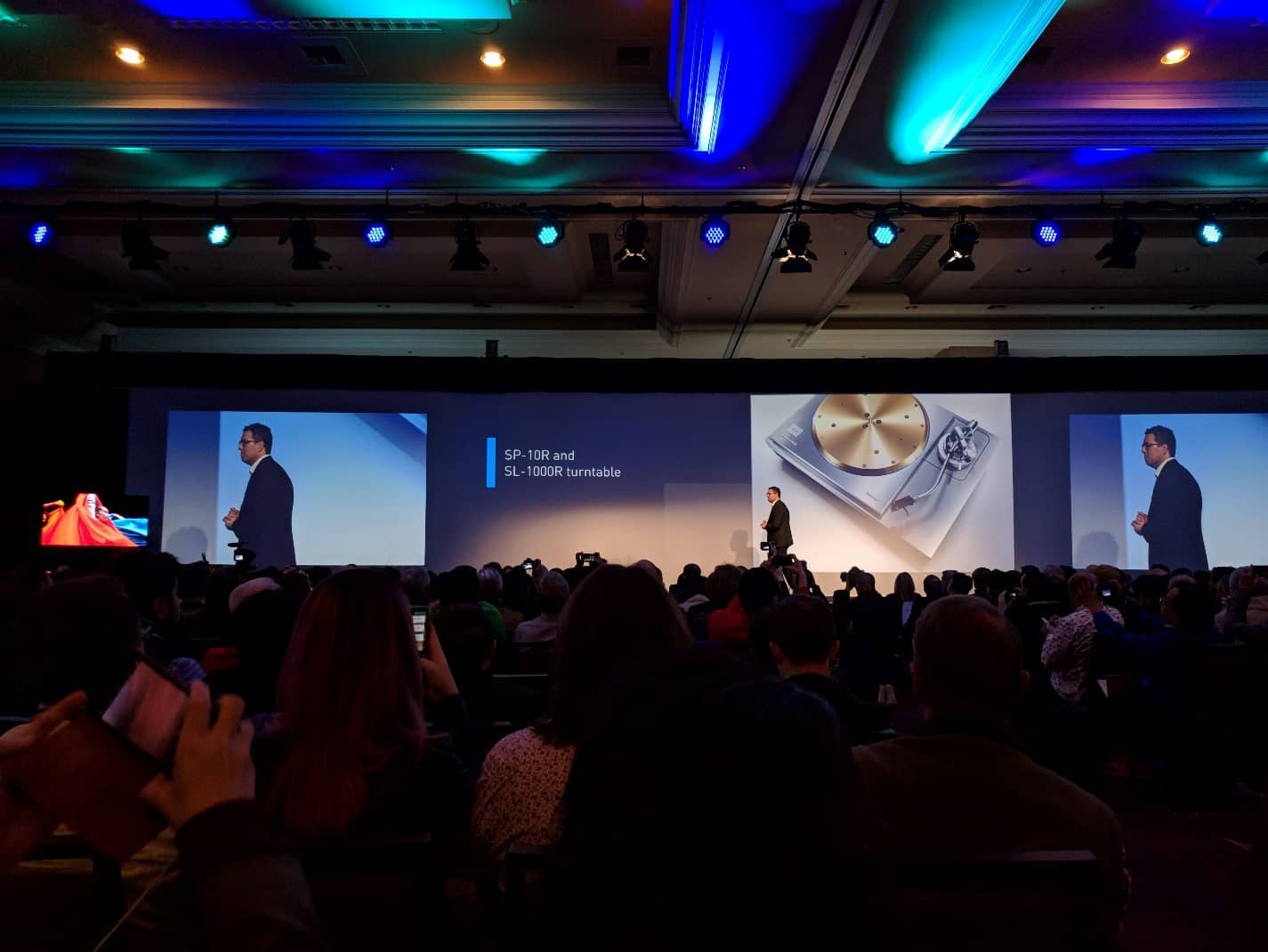
Continuing in the analog spirit… When the Technics SL-1200 record turntable debuted in 1972, its direct-drive technology made it an immediate hit not just with consumers but also with radio and club DJs. These robust “Wheels of Steel” played an essential role in the early years of hip hop record scratching and live dance music mixing. While the SL-1200 went out of production in 2010, many 1970s-era Technics remain in use today. At 2017’s CES, the coveted device began production once again. This year, Technics announced a new high-end turntable—the SL-1000R—which carries over the best qualities of the SL-1200. While the drastic rise in recent vinyl sales is often touted as a “revival,” the commitment of companies to produce quality turntables is evidence that the medium never really went away. 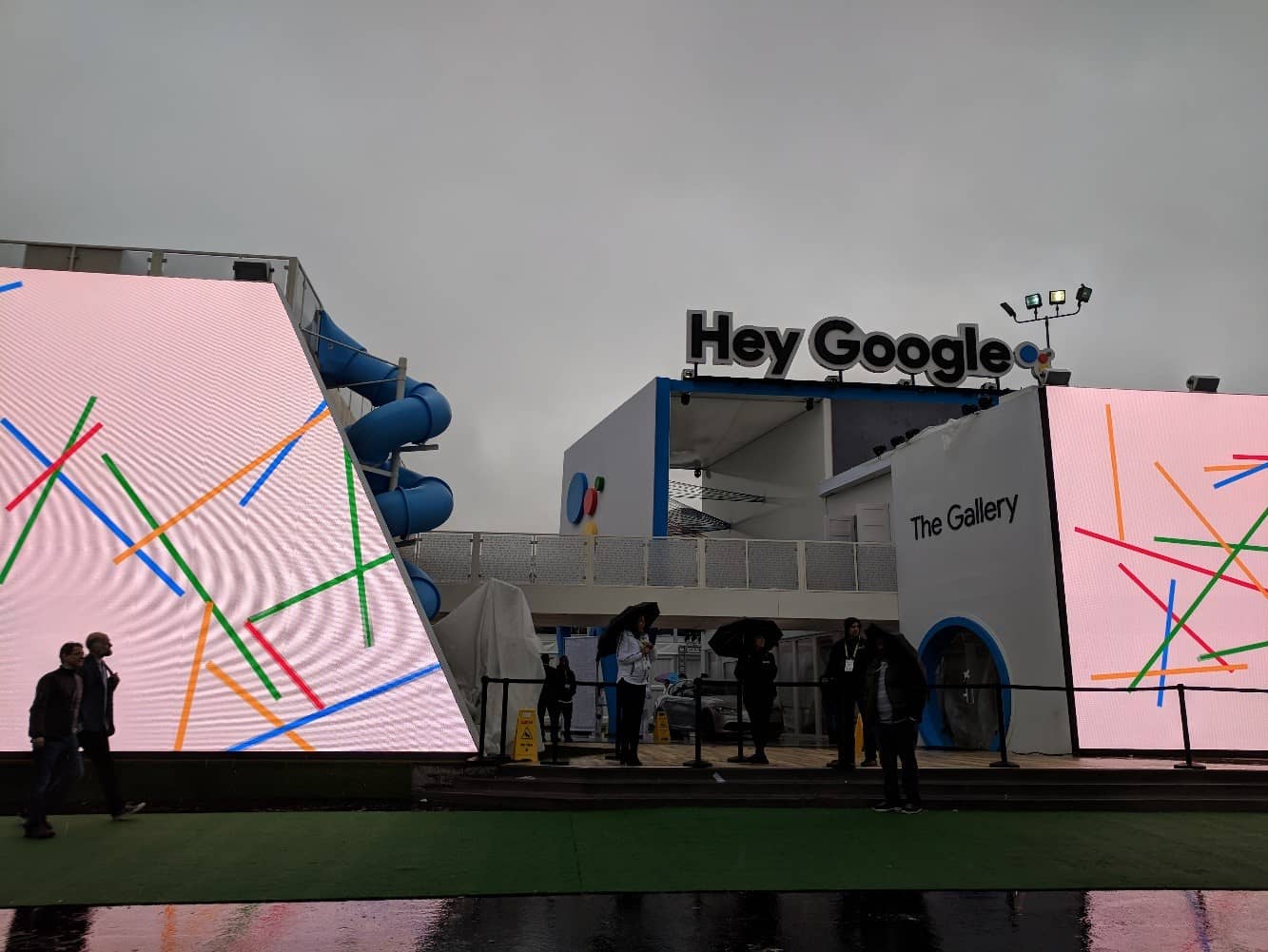
There was a lot of buzz at CES 2018 about the coming of the “voice assistant wars” between Amazon’s Alexa, Google Assistant, and a flood of startups finding their way into the mix. Voice-activated technology is nearly ubiquitous, as we have learned to ask Siri and Google for directions. And smart home devices—especially interactive speakers—have become more commonplace as we use them not only to listen to music and podcasts, but also to seek out information like weather, steps to a recipe, or to set up reminders. Our tech curator’s biggest CES disappointment was the heavy rains and floods that forced the Google Assistant booth to close, as well as that fun looking slide to the left.

Growing plants – that’s technology too! A variety of companies presented vertical hydroponic growing systems, geared towards health-savvy consumers who wish to take control of the food they consume. The SmallGarden by ēdn (right) and products by Opcom Farm (left) have married stylish, scalable design with LED lighting and intelligent automation.

And perhaps our tech curator’s favorite item at CES this year was this robotic duck, designed through a partnership between Aflac and Sproutel. The award-winning “My Special Aflac Duck” is designed to help children cope with cancer treatment. Its touch sensors respond with soothing sounds when it is cuddled with, and it teaches young children calming breathing exercises while they undergo IV treatments. Round RFID chips containing emoji faces are meant to mirror emotions—when tapped against the duck, the toy will then reflect its patient’s feelings by groaning or quacking happily. An accessory even allows kids to play out administering “medication.” These features combine to allow young patients to communicate their emotions effectively, take on the role of caregiver, and reduce anxiety. The duck will be tested at an Atlanta treatment center this year, with the future goal of donating the social robot to any child diagnosed with cancer, nationwide.
While it’s not quite the North American International Auto Show, CES is an increasingly important venue for automakers to debut new technologies, or to announce new partnerships with tech-savvy firms. If the automotive side of this year’s show was to be captured in a single word, it’s “autonomy.” Self-driving vehicles are on everyone’s mind – we’re no longer talking about this tech in terms of “if,” but “when.”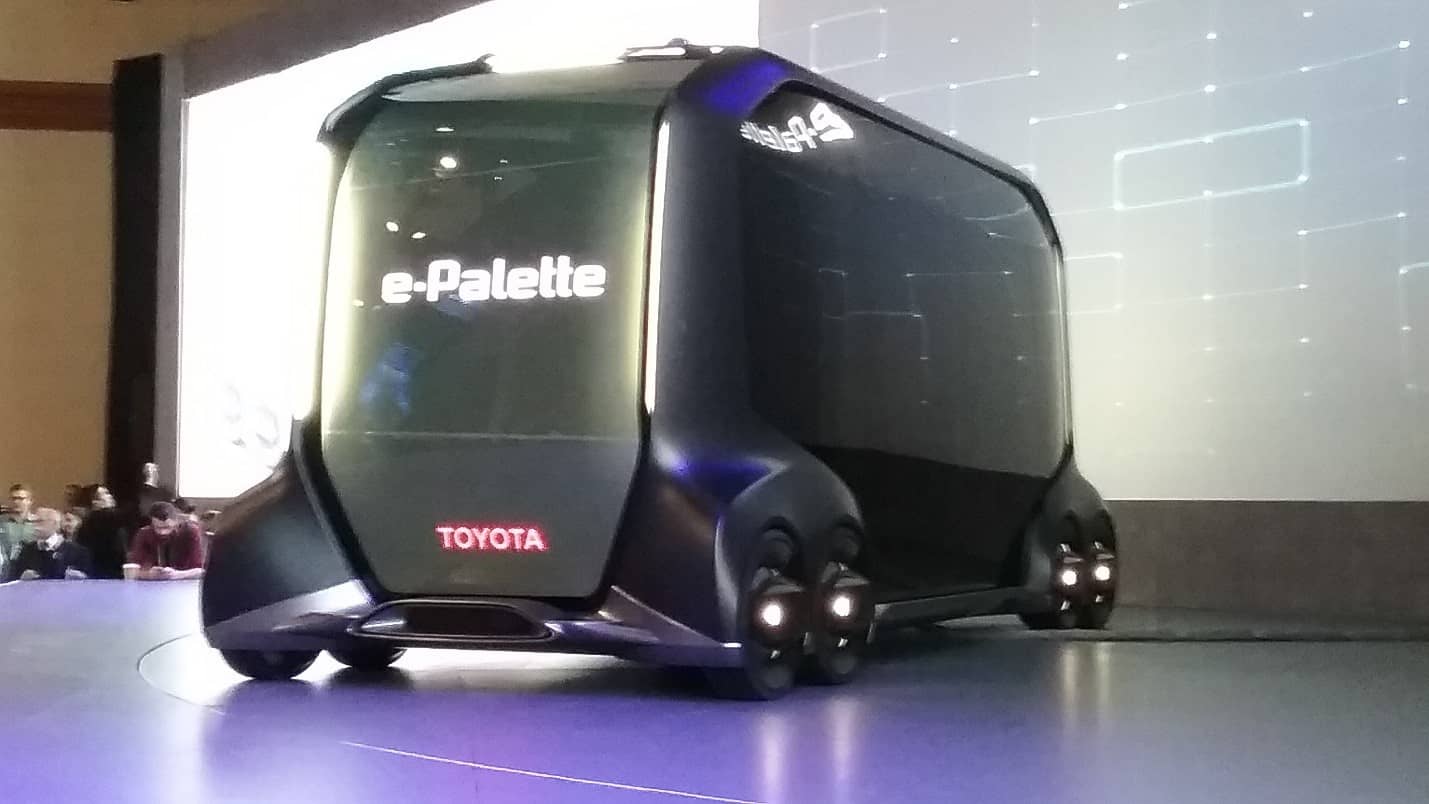
Toyota president Akio Toyoda spoke clearly to the growing overlap between the automotive and tech worlds when he noted that his company’s competitors now include not only carmakers like General Motors, Volkswagen and Honda, but also firms like Google, Apple and Facebook. Toyoda sees the car evolving into a personal assistant, using predictive artificial intelligence to anticipate the travel needs of its owner. And, like a growing number of other industry members and observers, he also predicts the inevitable – if slow – extinction of the internal combustion engine. Toyota and Lexus plan to offer electric or hybrid versions of every one of their models by 2025.
Toyota’s big CES announcement focused on its e-Palette concept (above). The fully-autonomous electric vehicle is designed for maximum flexibility. An e-Palette could serve as a bus providing ride sharing services. It could work as a mobile store bringing goods to your front door on demand. It could even function as a rolling flexible workspace, giving us back some of those 38 hours that the average American loses to traffic congestion each year. Companies like Amazon, Pizza Hut and Uber have already agreed to partner with Toyota in e-Palette’s development.
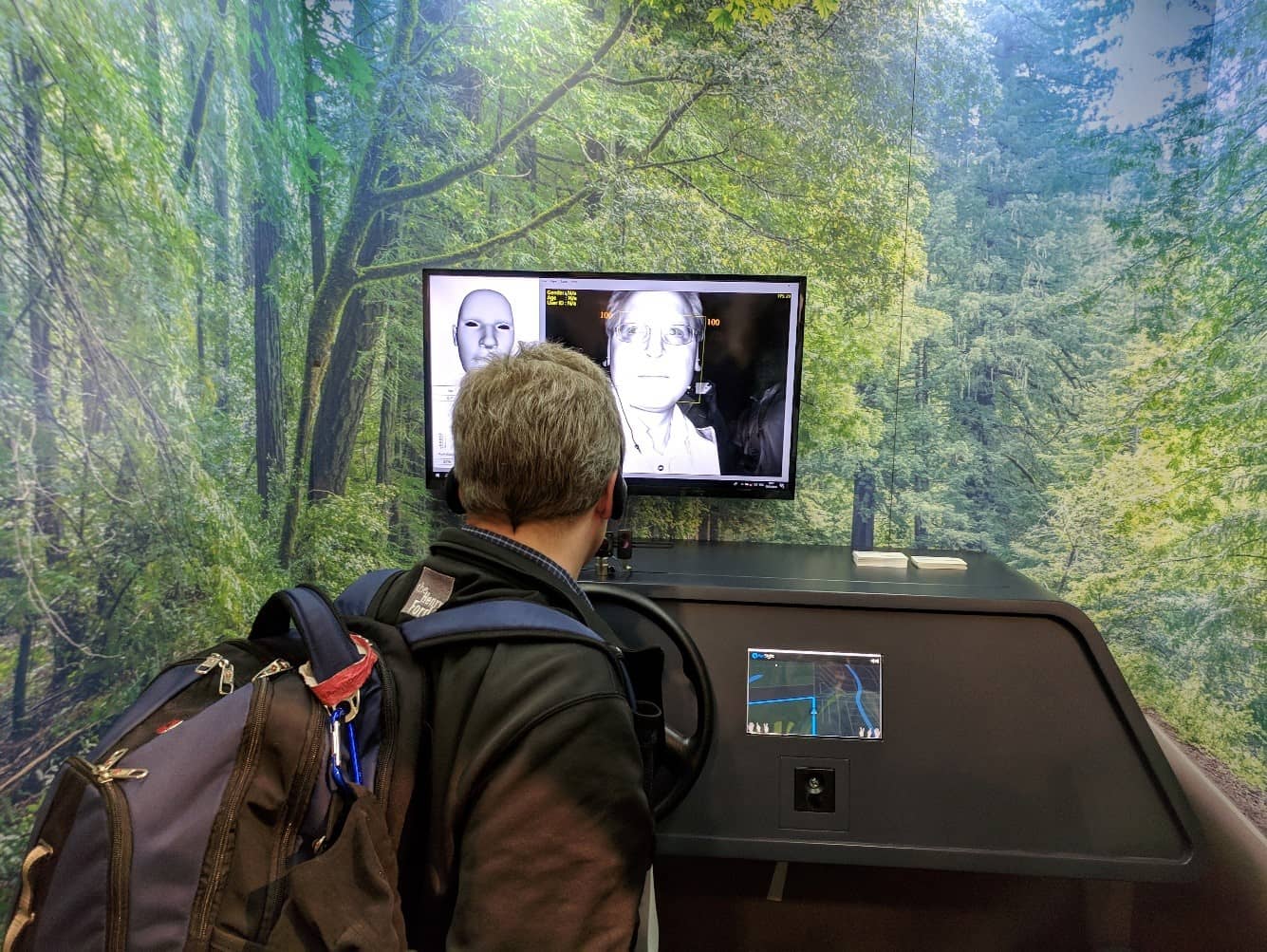
Self-driving cars offer more than mere productivity. Safety promises to be their greatest benefit. Some 35,000 people die in motor vehicle accidents in the U.S. each year, and 90 percent of those accidents are due to human error. Eliminate the human element, so the thinking goes, and you eliminate the vast majority of those deaths.
Sophisticated lifesaving tools are here today. CES exhibitor eyeSight Technologies uses in-car sensors to track driver eye movement, blink rate and head pose (above). Look away from the road – say, at your phone – for too long and the system can trigger an audible alarm. Blink too often or for too long – perhaps because you’re too drowsy to drive – and the system could conceivably cause the car to slow down and pull off to the side of the road.
There are still many problems to solve before we have fully-autonomous cars in every garage. Who’s liable in an accident? The carmaker, the programmer, the owner? What happens when you’re traveling in a remote area with poor broadband service – and no GPS? What happens in the “transition” period, when self-driving cars share the road with human-driven vehicles? Can they communicate with one another? And the biggest question of all: Will people be comfortable putting their lives in a computer’s hands? But, ready or not, this new world is coming. In fact, it had already arrived at CES – Lyft and Aptive partnered to provide rides around Las Vegas in autonomous BMWs.
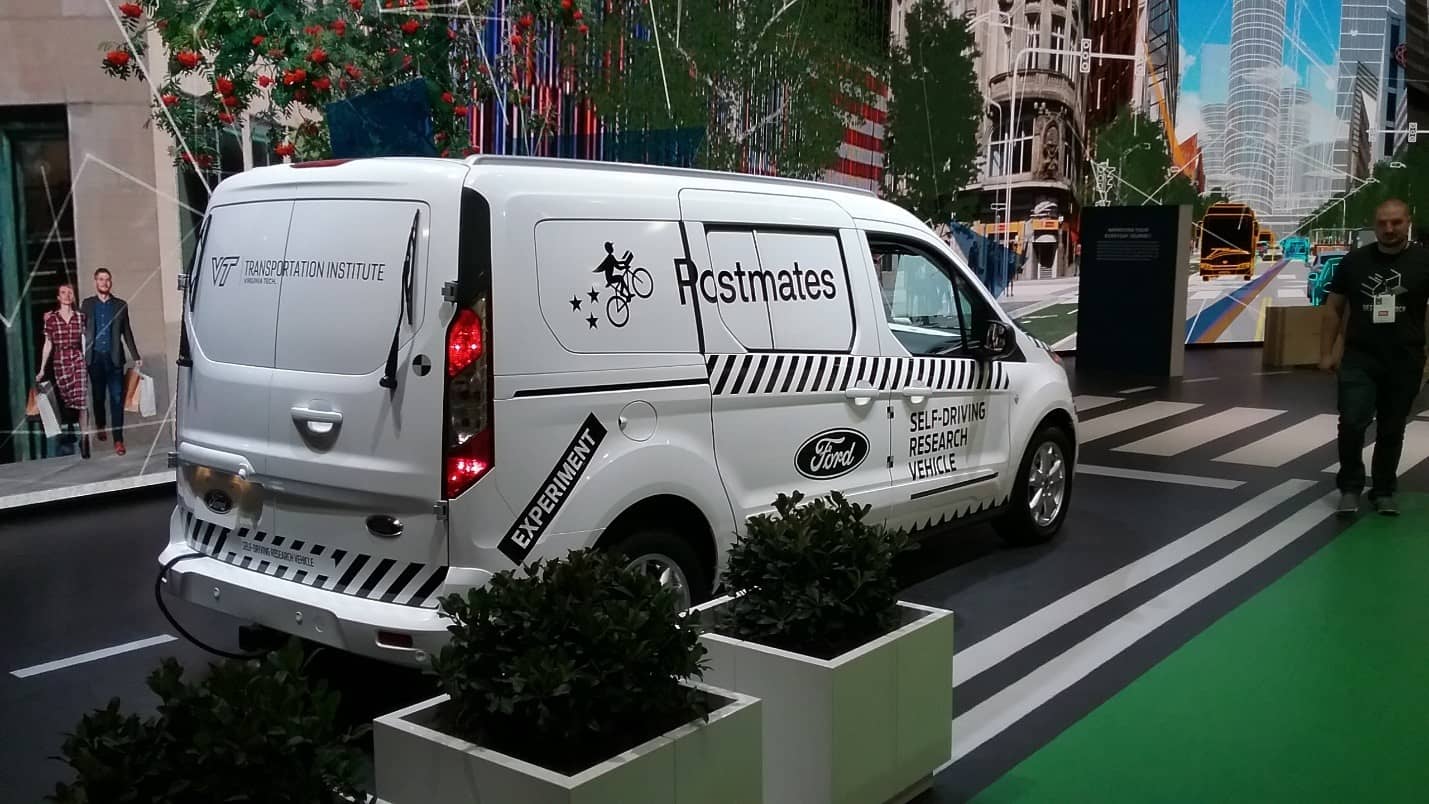
When you think about the relationship between humans and self-driving cars, remember that it’s not just the humans inside the car. How pedestrians, cyclists and other street users interact with an autonomous vehicle is equally important. Ford’s CES booth featured a van at the center of an interesting research project (above). In the study, a driver camouflages himself in a seat-cover costume – yes, really – and then drives around gauging people’s reactions. How disconcerting is it to see an empty van rolling toward the crosswalk? And how confident can you be that it’ll stop for you?
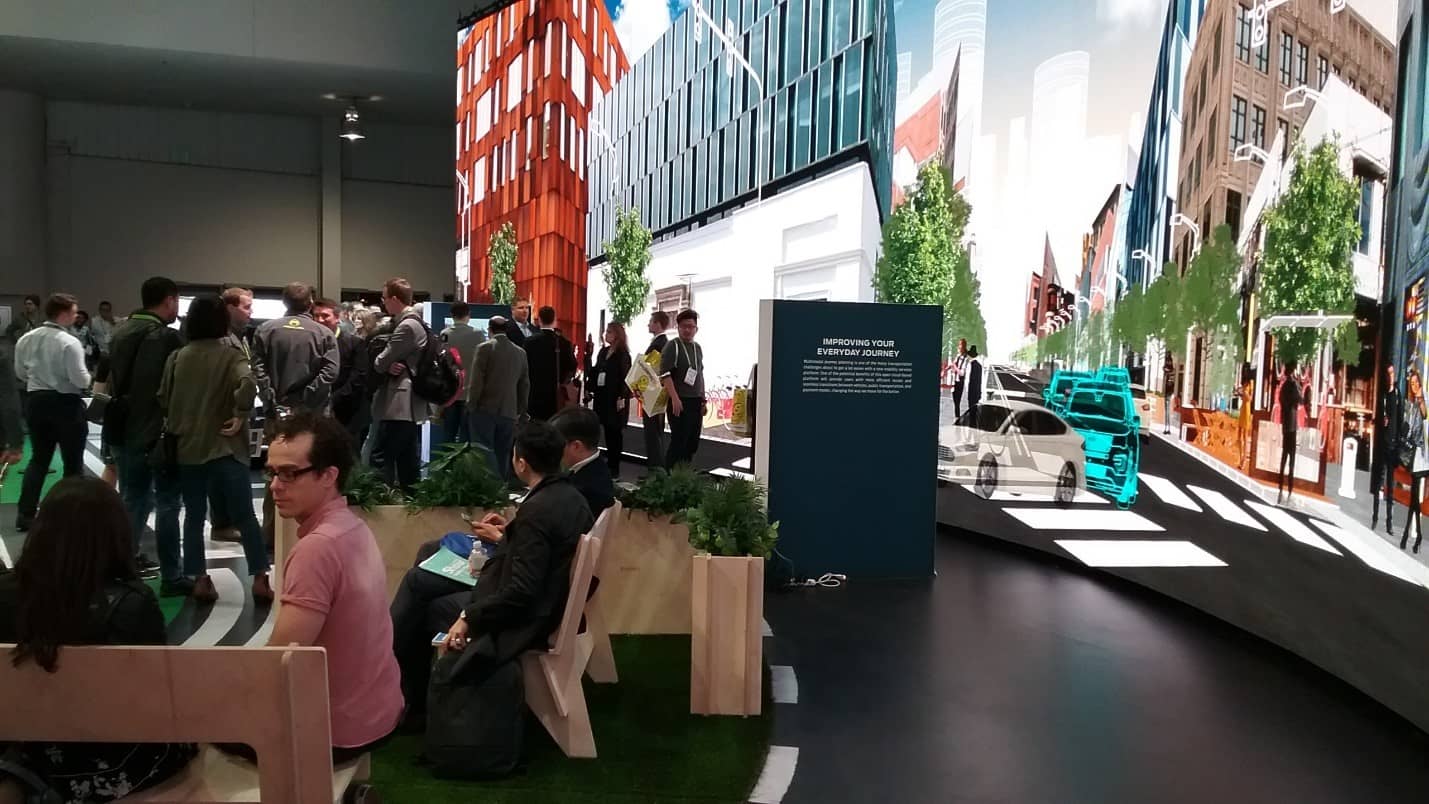
Ford and Toyota both emphasized that they’re not in the car business anymore – they’re in the mobility business. The recreated streetscape in Ford’s booth included not only the van and an autonomous Fusion sedan, but also bicycles, skaters and pedestrians. Ride sharing and self-driving vehicles will reduce traffic, either by cutting the number of cars on the road, or by using roads more efficiently. It’s a dream come true for urbanists who’ve long searched for ways to reclaim pavement for uses other than moving and/or parking cars. (Ever hear the term woonerf? You will!) In fact, Ford’s street even included park benches and grass in a reclaimed lane (above).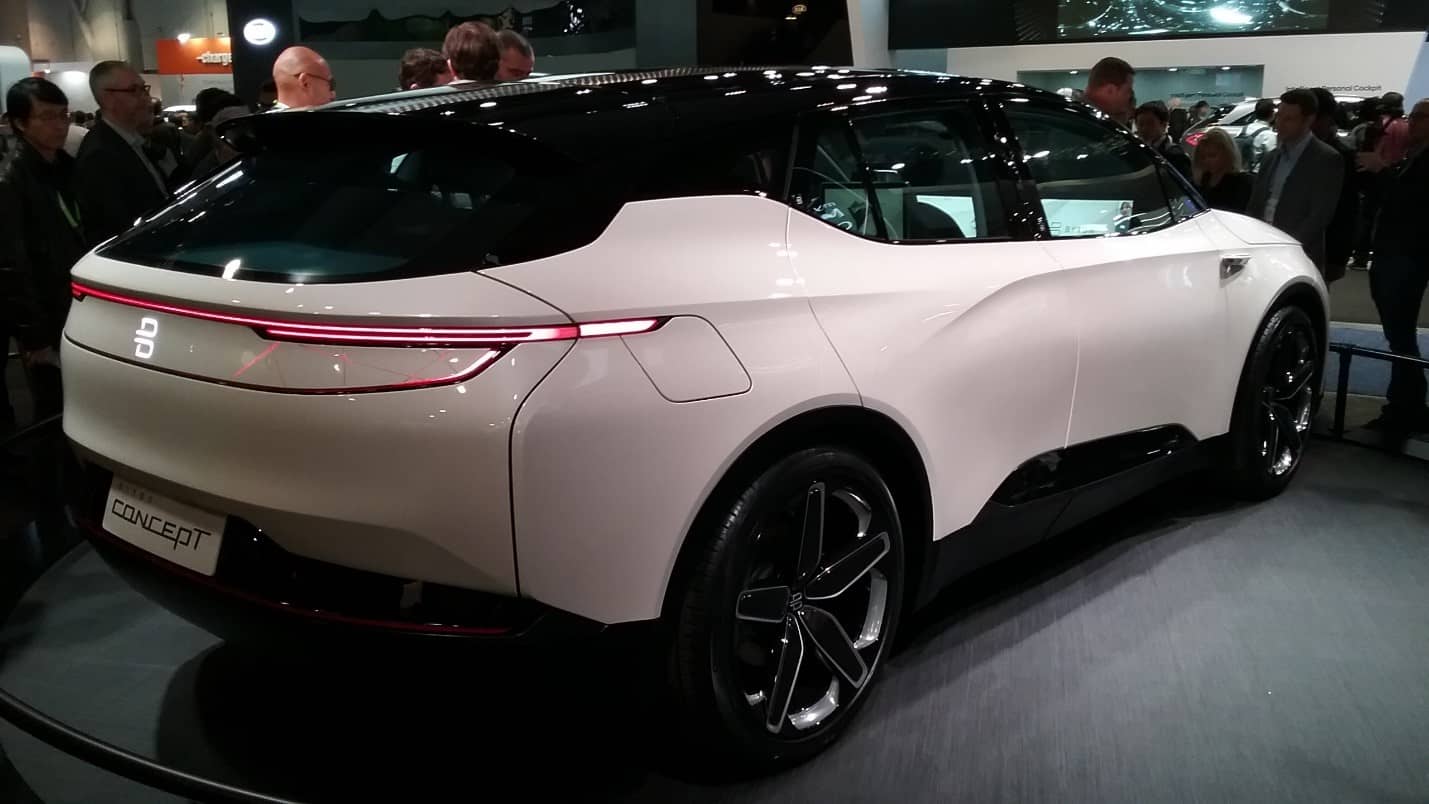
The twin revolutions of the electric powertrain and autonomous capability may provide the best opportunity to get into the car business since just after World War II. Few newcomers attracted as much attention at CES as Byton. The Chinese manufacturer plans to enter the American market in 2020 with a battery-powered Level 3 autonomous car capable of up to 325 miles between charges (above). Instead of a dashboard, Byton’s car uses a 49-inch screen. And instead of knobs and buttons – or even a touchscreen – passengers control the car’s features with hand gestures. And you don’t even have to worry about locking your keys in the car – the Byton’s doors are unlocked with facial recognition software.
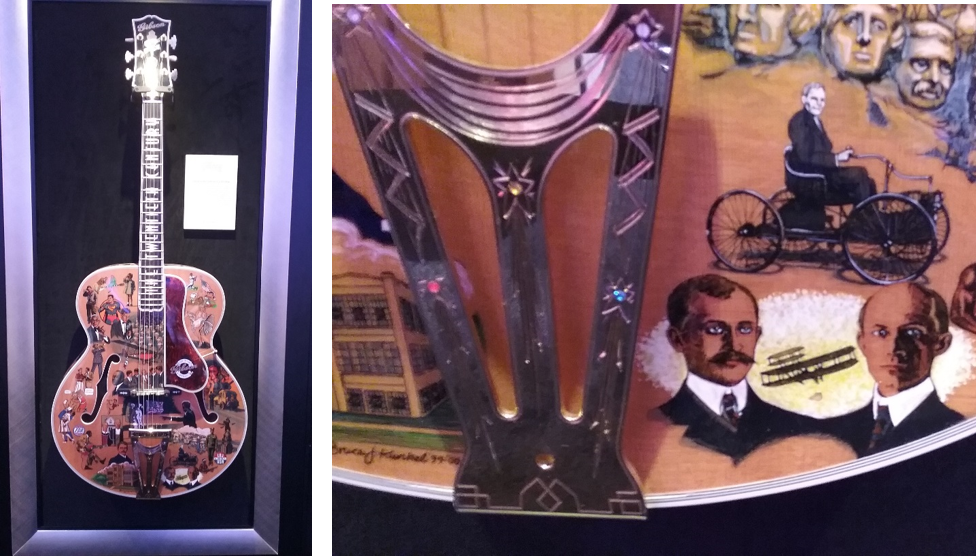
And finally, for something completely different, the prize for Most Unexpected Quadricycle Sighting goes to… Gibson Guitars (above). The company’s special edition “20th Century Tribute” archtop, on display in its CES tent, featured images of influential people, technologies and events from the past century. Note that Orville and Wilbur Wright had a well-deserved spot, too!
Kristen Gallerneaux is Curator of Communication & Information Technology at The Henry Ford. Matt Anderson is Curator of Transportation at The Henry Ford.
autonomous technology, cars, communication, music, photography, events, technology, by Matt Anderson, by Kristen Gallerneaux

